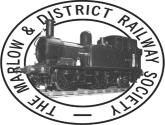
2014
| Other years available: | 2024 | 2023 | 2022 | 2021 | 2020 | 2019 | 2018 | 2017 | 2016 | 2015 | 2014 |
2013 |
| HOME | ABOUT US | PROGRAMME | THE DONKEY | GALLERY | LOCAL RAILWAYS | LINKS |
Banbury Signal Boxes
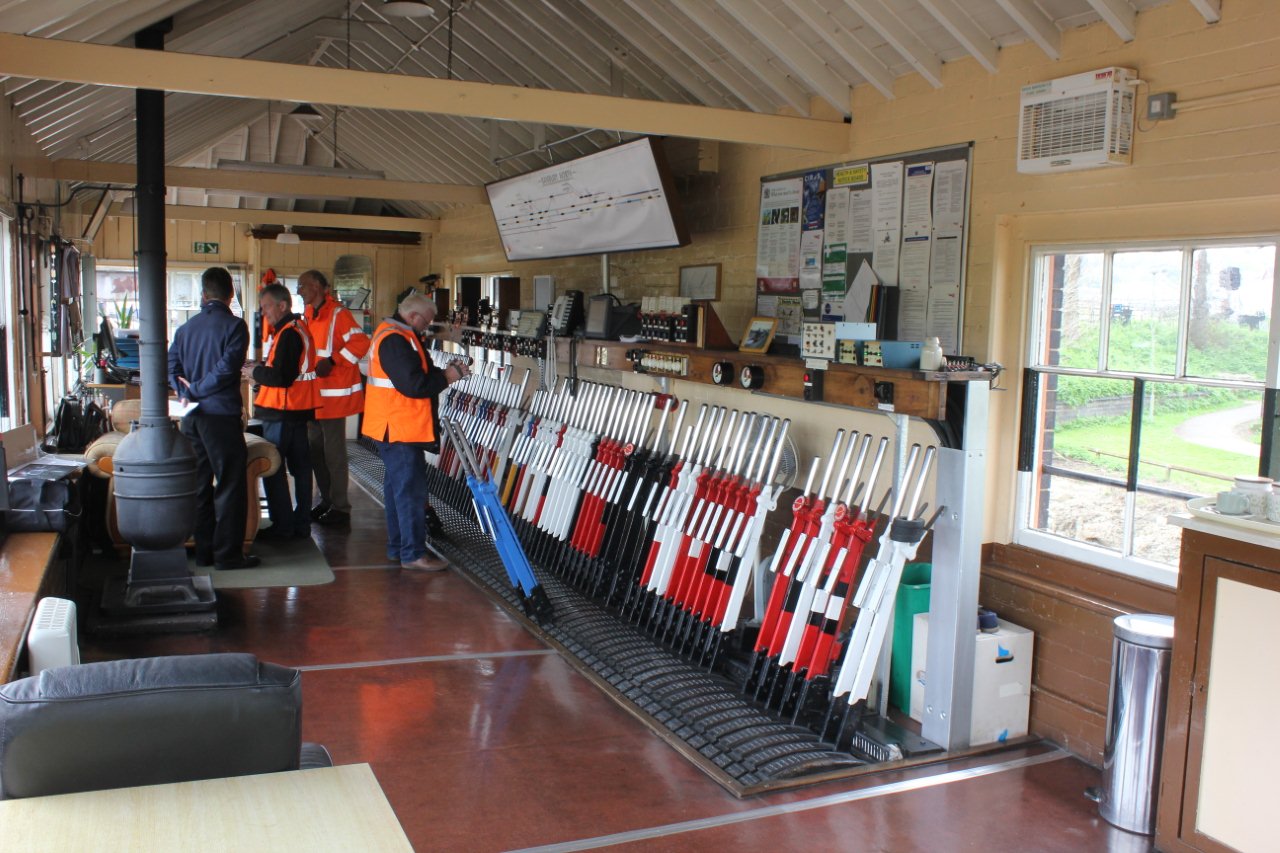 |
Banbury North Box, 12 April A small group of MDRS members visited the Banbury Signal Boxes, this view of the North Box's lever frame looking North, clearly shows the different functionality of the levers by colour, and the shorter levers which connect electronically. (Mike Walker) |
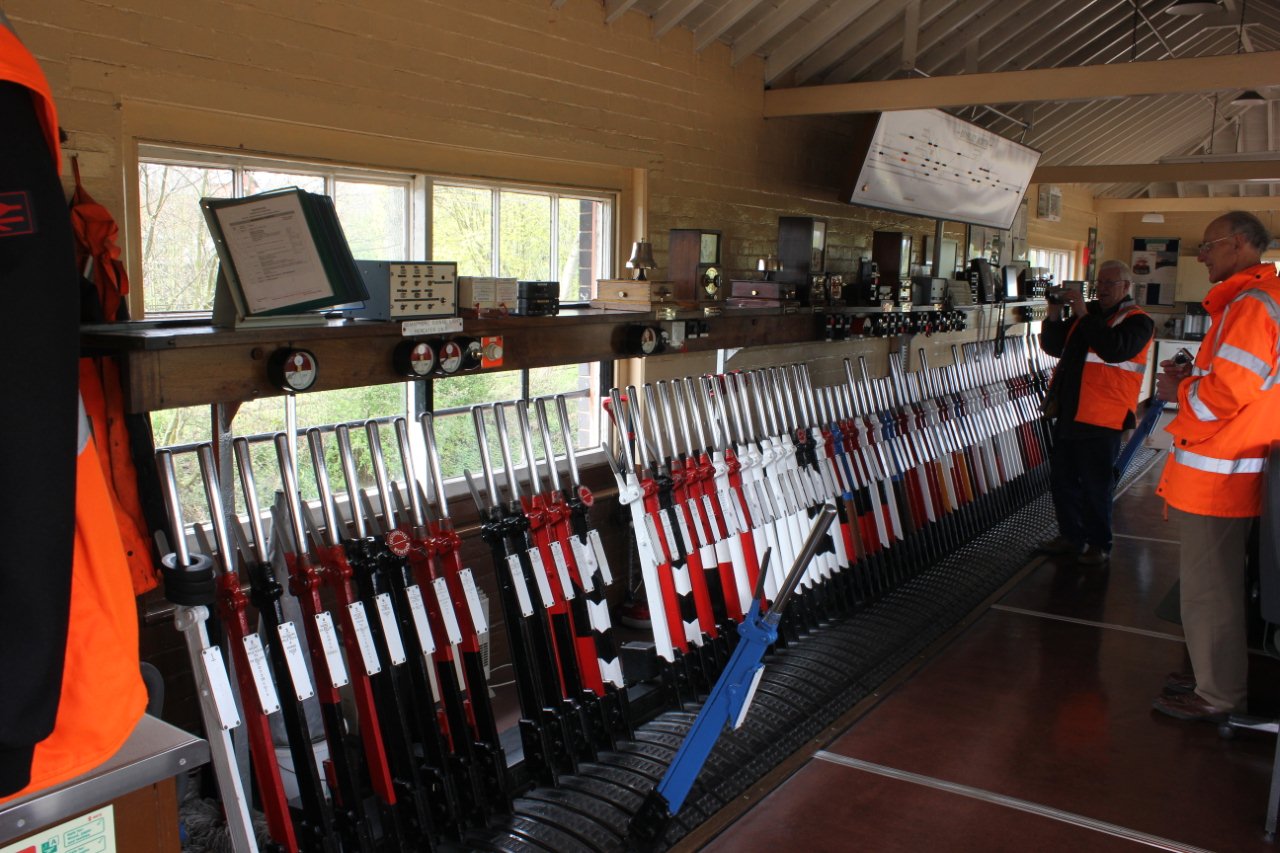 |
Banbury North Box, 12 April This view is still in the North Box but looking South. (Mike Walker) |
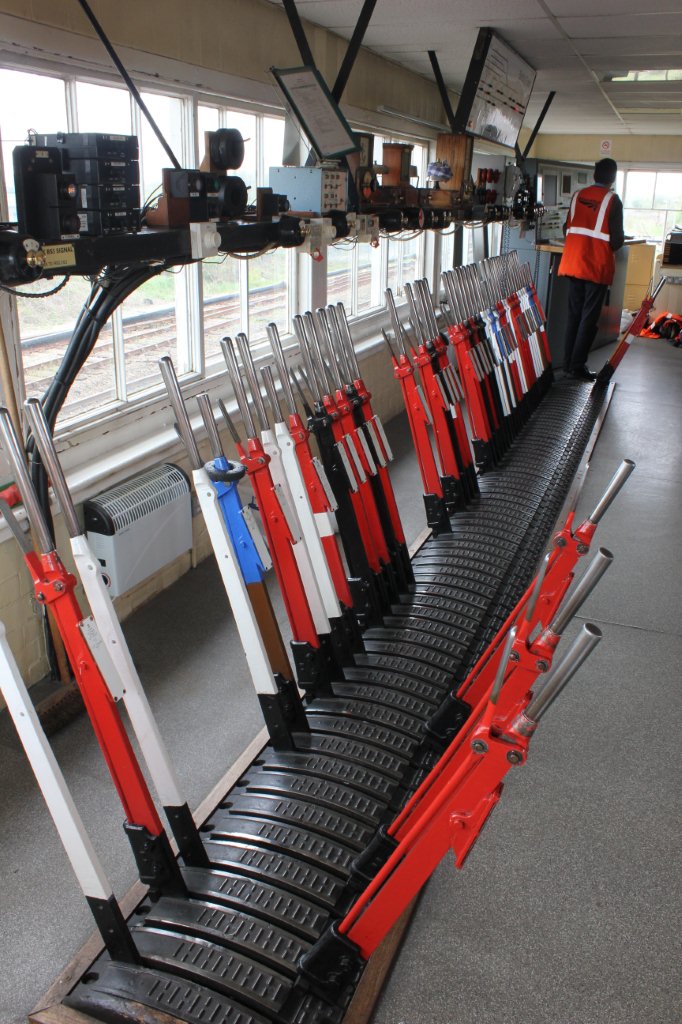 |
Banbury South Box, 12 April The MDRS group have now moved to the South Box, this is the view looking South. (Mike Walker) |
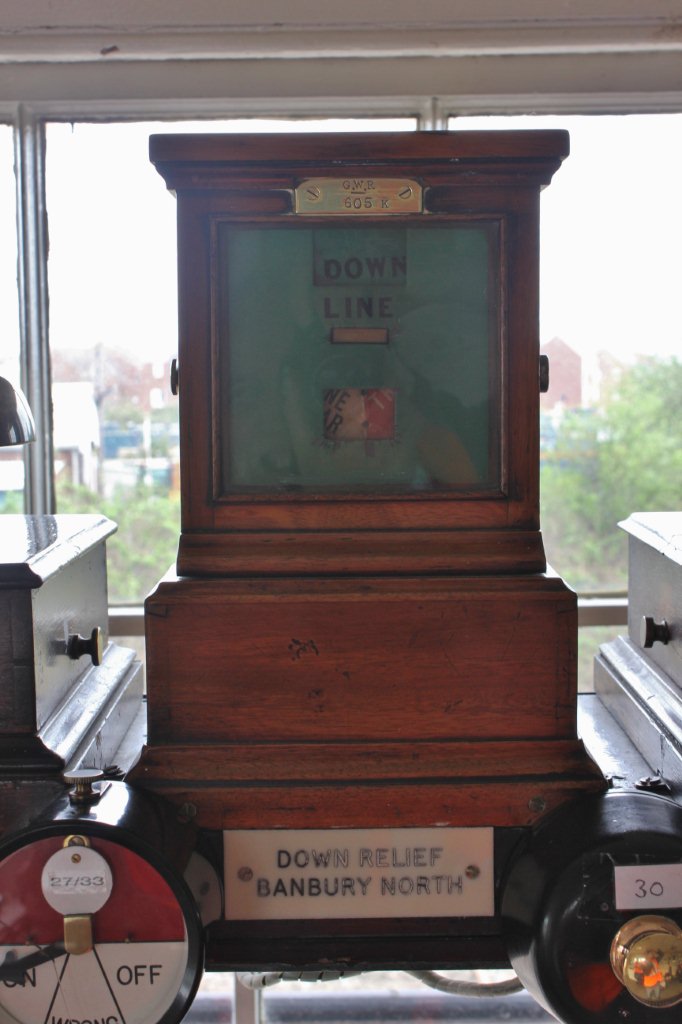 |
Banbury South Box, 12 April The Spagnoletti instrument in the South Box dates from sometime in the late 19th Century, and is the last surviving example in service on Network Rail. As the plate shows, it is the receiving instrument from Banbury North for the Down Relief line(through platform 1), the moving disc has two positions, Line Clear and Line Blocked because this was normal practice at the time. (Mike Walker) |
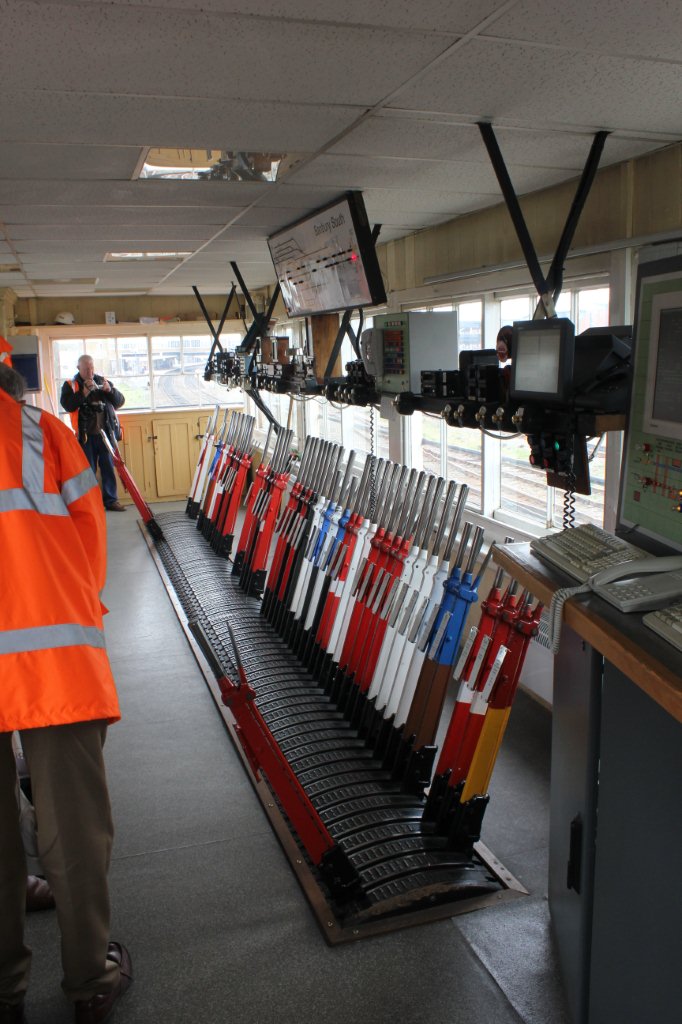 |
Banbury South Box, 12 April This view looking North from the South Box, again shows the shorter levers for electrical operation and the colour coding. (Mike Walker) |
Rail Live 2014 at Long Marston
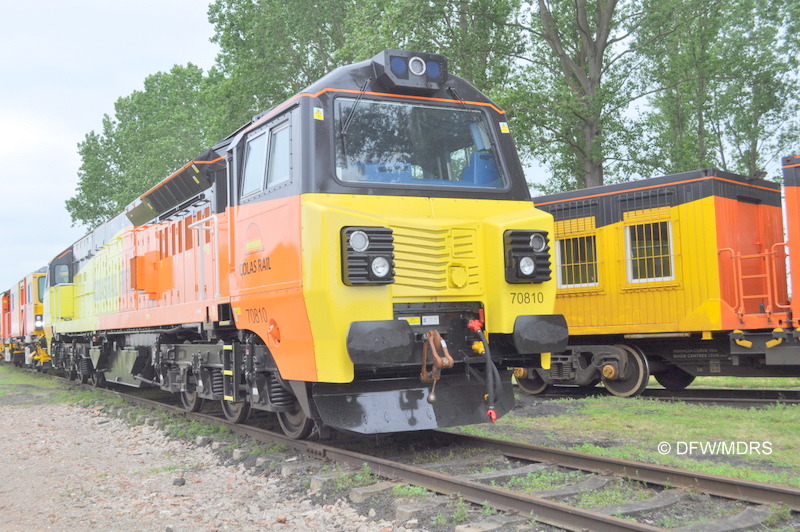 |
Long Marston, 18 June 70810 is the last of a batch of 10 to be ordered by Colas Rail, and only arrived into the UK 0n 26th May 2014. (Dave Woodhead) |
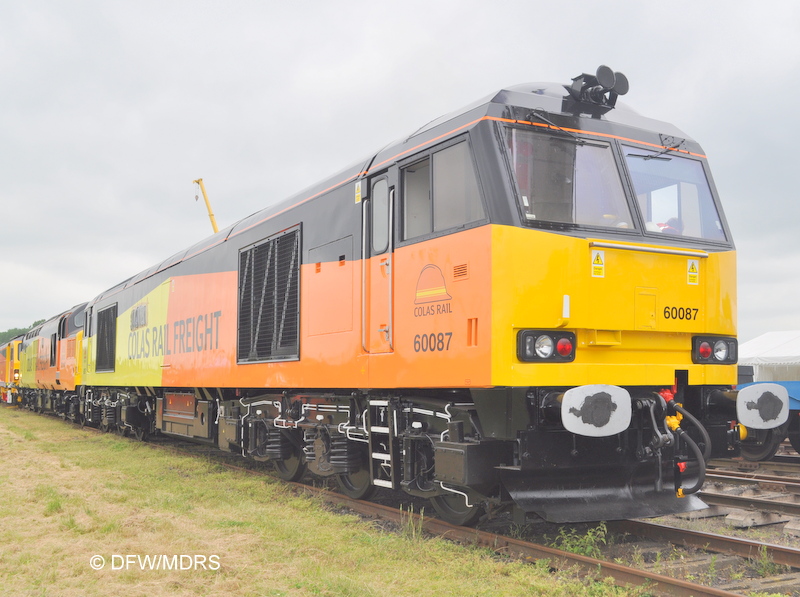 |
Long Marston, 18 June Class 60, 60087 is the first of a batch of 10 to be purchased by Colas Rai from DB Schenker. It had been stored for some time at Toton, and the refurbishment only completed in late May 2014. During the event, the class 60 was named "CLIC Sargent"after the children's cancer charity. CLIC Sargent was the official charity for the event, and after the naming ceremony, they were presented with a cheque fo 15,000 for the first part of the fund raising activities. (Dave Woodhead) |
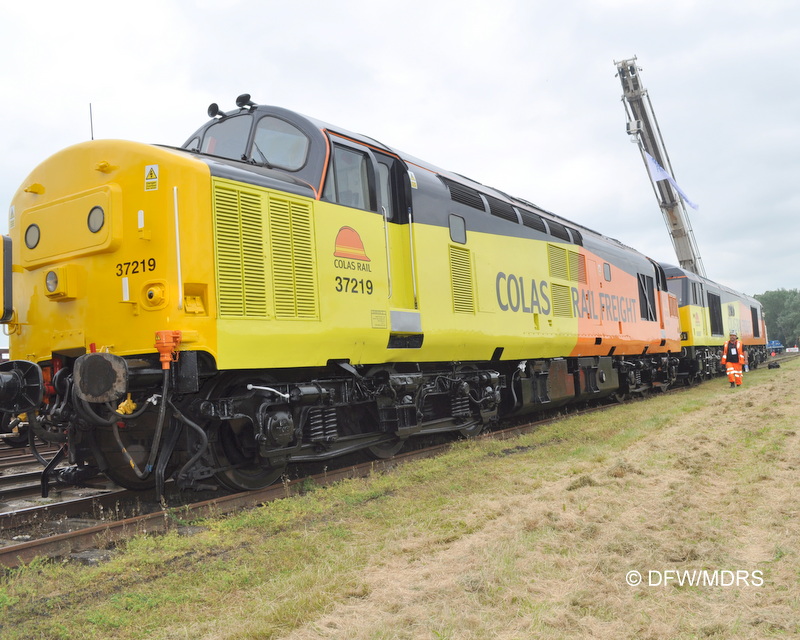 |
Long Marston, 18 June Colas Rail 37219, has just been re-painted into house colours, and only returned to mainline duties on 12th June 2014. (Dave Woodhead) |
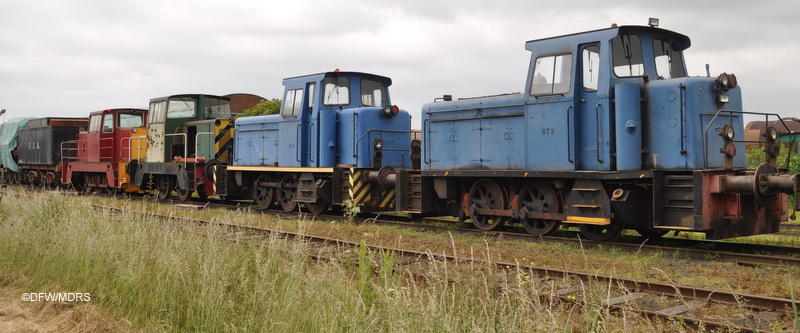 |
Long Marston, 18 June A collection of diesel shunters,and the tender of USATC S160 2-8-0.The locomotive was also stored near the tender, but was totally enclose with large sheets, and it was not possible to obtain a photograph. The two blue diesel locos 870 and 873 have been used by Europhoenix as yard shunters, and the S160 has been confirmed as being part of the "Military Railfest 2015" to be held at Long Marston from May 6-10 next year. (Dave Woodhead) |
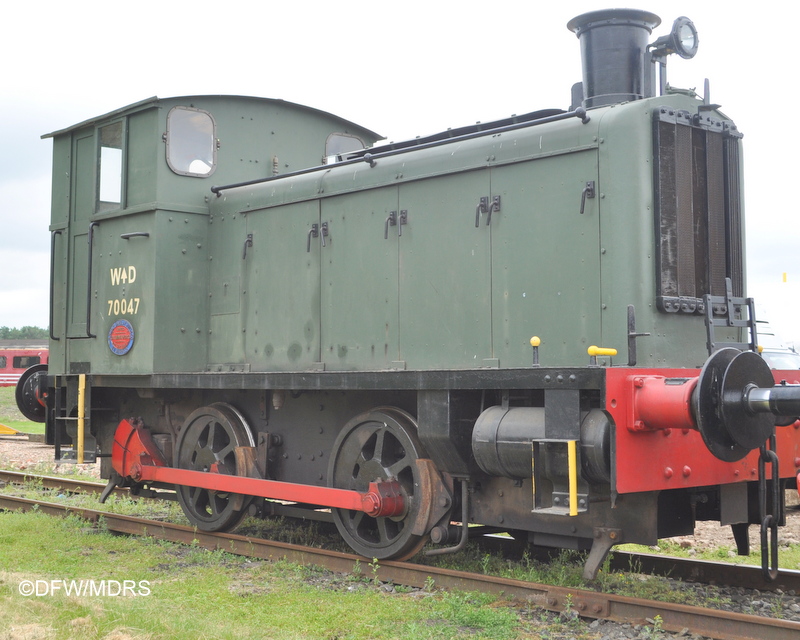 |
Long Marston, 18 June An Andrew Barclay built 0-4-0 shunter built for War Department, with a 150 hp Gardner engine, and was used in France 1944-46 and the Middle East 1952-55. Has been based at Long Marston since 2009, and originaly named "Mulberry". 70047 will also be on display at "Military Railfest" (Dave Woodhead) |
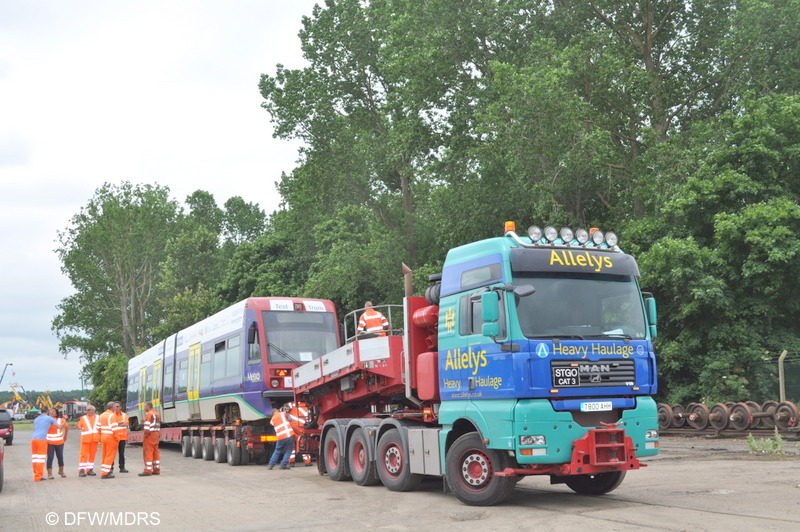 |
Long Marston, 18 June Test Tram No 14 is being delivered to Long Marston by Alleys Heavy Haulage. This is the first of the Midland Metro Trams to be withdrawn, and carries the name "Jim Eames", and used to opperate between Birmingham Snow Hill and Wolverhampton. While at Long Marston it will be used by the RSSB Future Railway team. (Dave Woodhead) |
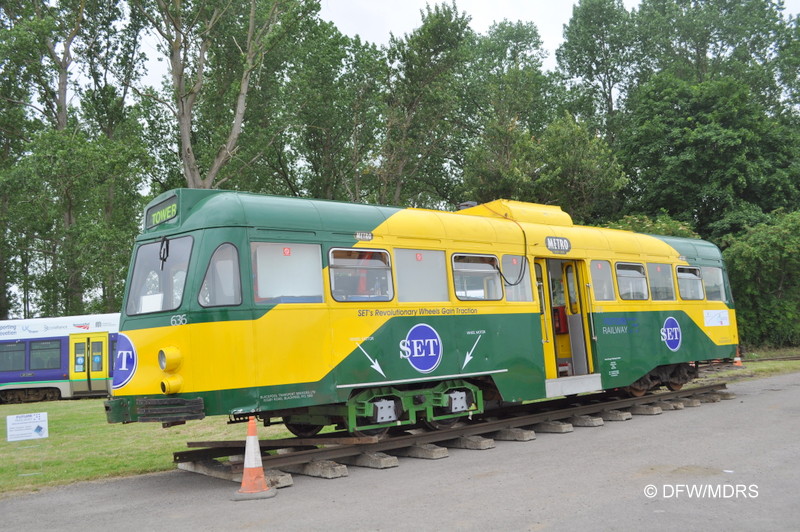 |
Long Marston, 18 June Brush Railcoach Car 636, was originally part of the Blackpool Tram fleet, but is now owned by Stored Energy Technology (SET). It was used as a test bed in 2009 with an aim to develop a lighter and more efficient method of powering electric trams. It's long term future is uncertain, as three of the type are preserved in Blackpool Transport's heritage fleet, and several others also preserved at Crich and Heaton Park. (Dave Woodhead) |
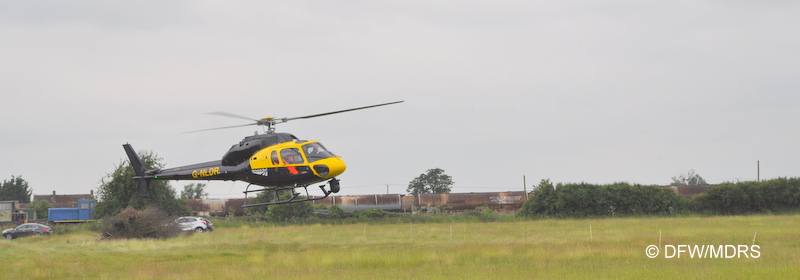 |
Long Marston, 18 June Eurocopter AS355F2, call sign G-NLDR, is one of a pair opperated by Network Rail and this one covers Network Rail Long Distance and Regional. The tasks undertaken include the monitoring the effectiveness of points heaters in the winter, and indentifying power spikes in overhead wires and lineside equipment, and viewing the integrity of lineside fencing to reduce trespass and vandalism. (Dave Woodhead) |
Slough Panel Signal Box
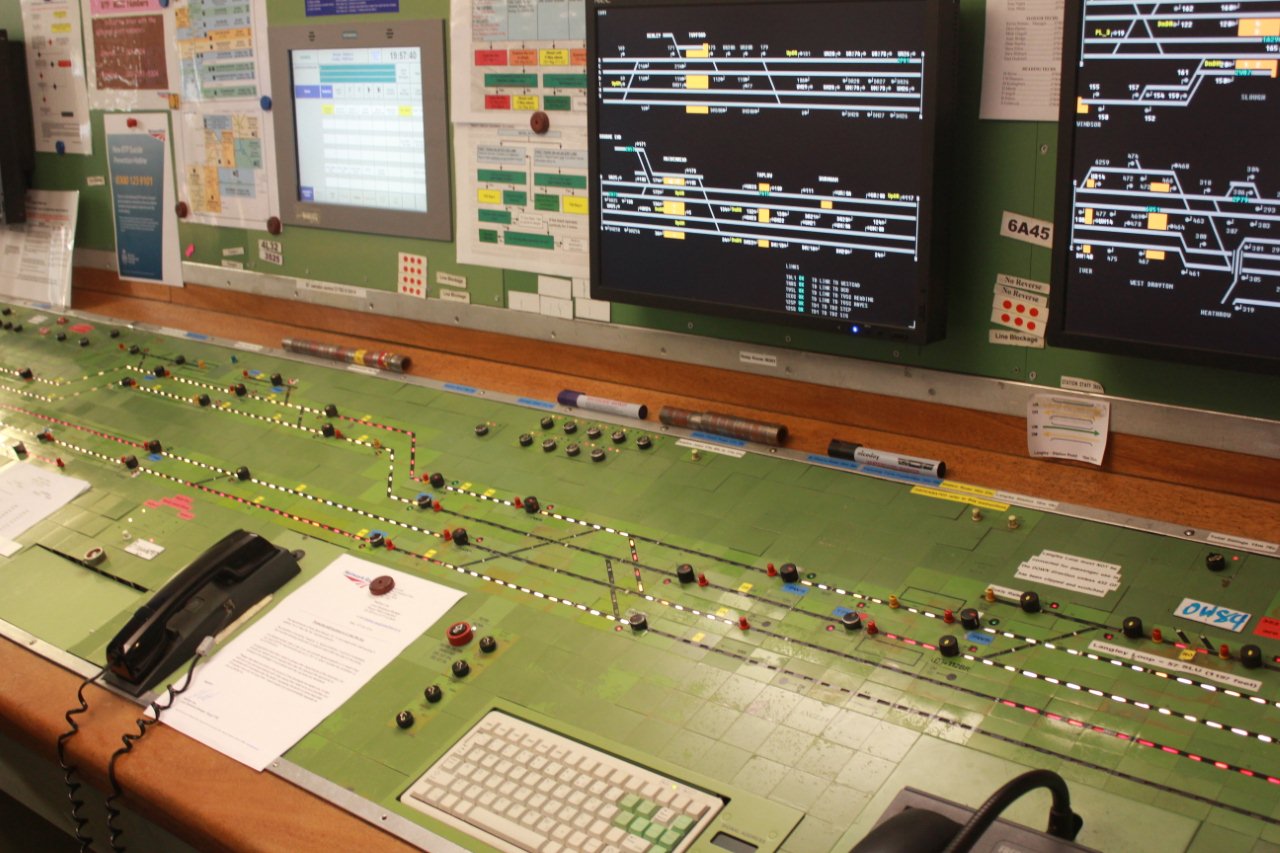 |
Slough PSB, 7 August Slough Panel, showing the section from Slough Station (on the left) to Langley. Note that a route is set from the Up Relief to the Up Main at Dolphin Junction. (Mike Walker) |
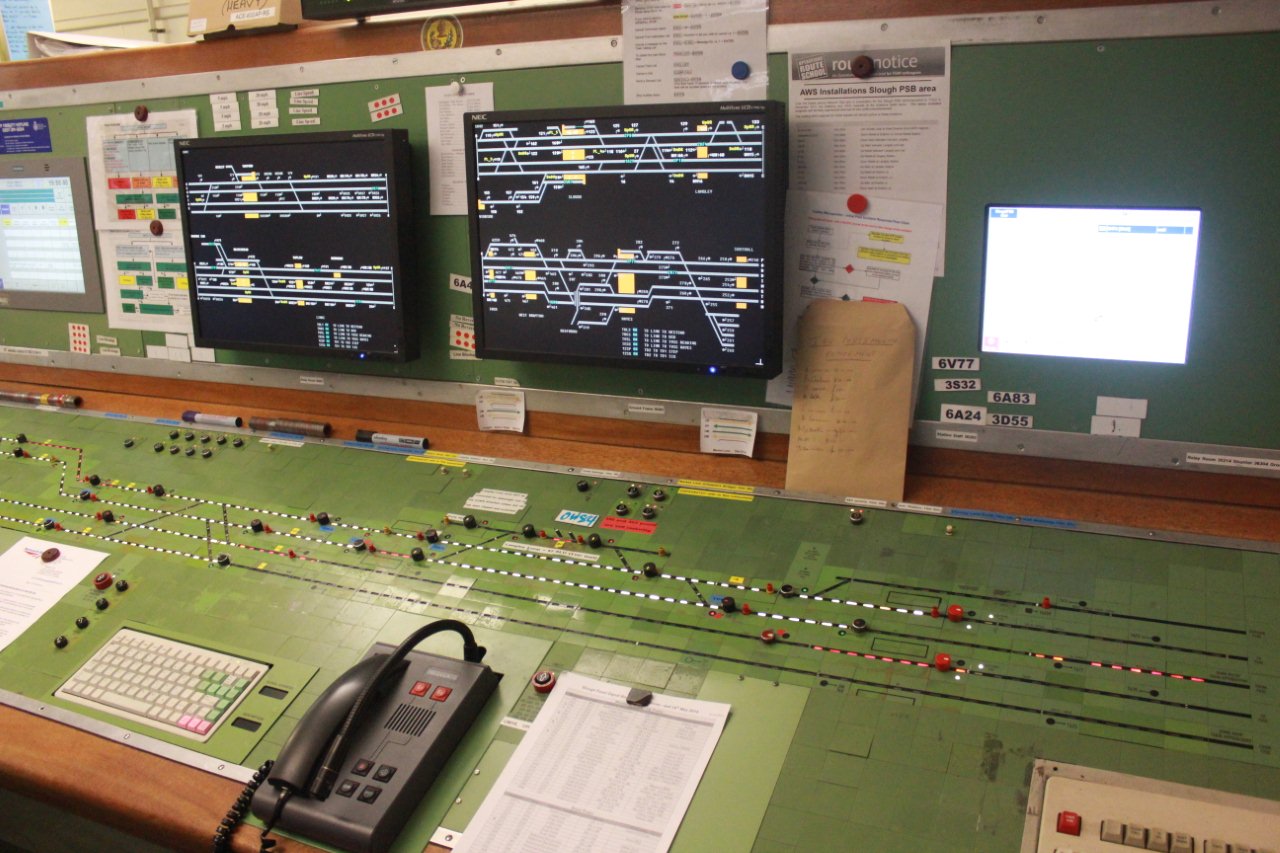 |
Slough PSB, 7 August Slough Panel, showing the area from Dolphin Junction (on the left) to Iver. Note the "aide memoir" at Langley reminding the signaler that there was a loco in the sidings. (Mike Walker) |
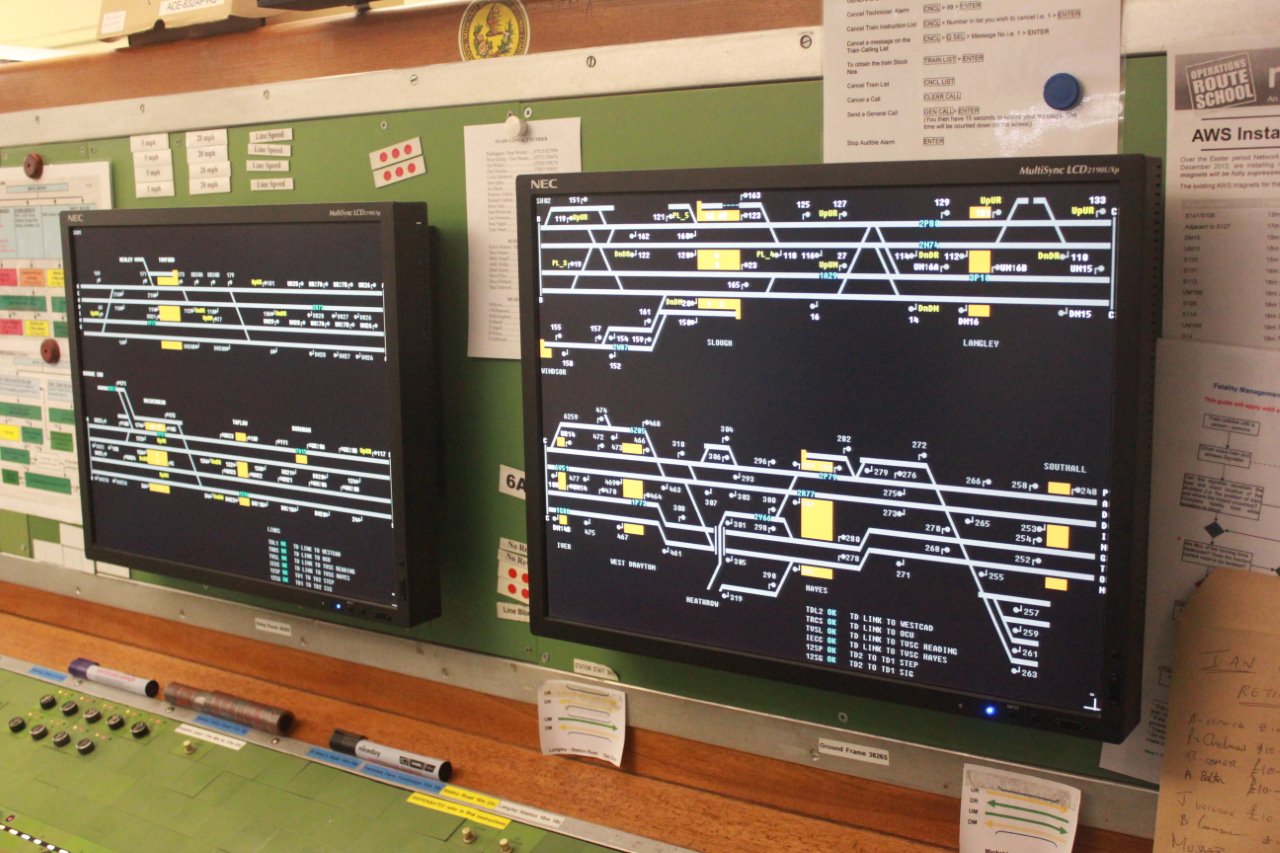 |
Slough PSB, 7 August A close up of the VDU train describers at Slough Panel. The left one covers the area from Maidenhead to Farnham Road, and the one on the right continues on to Southall, giving the signalleran overview of the area. (Mike Walker) |
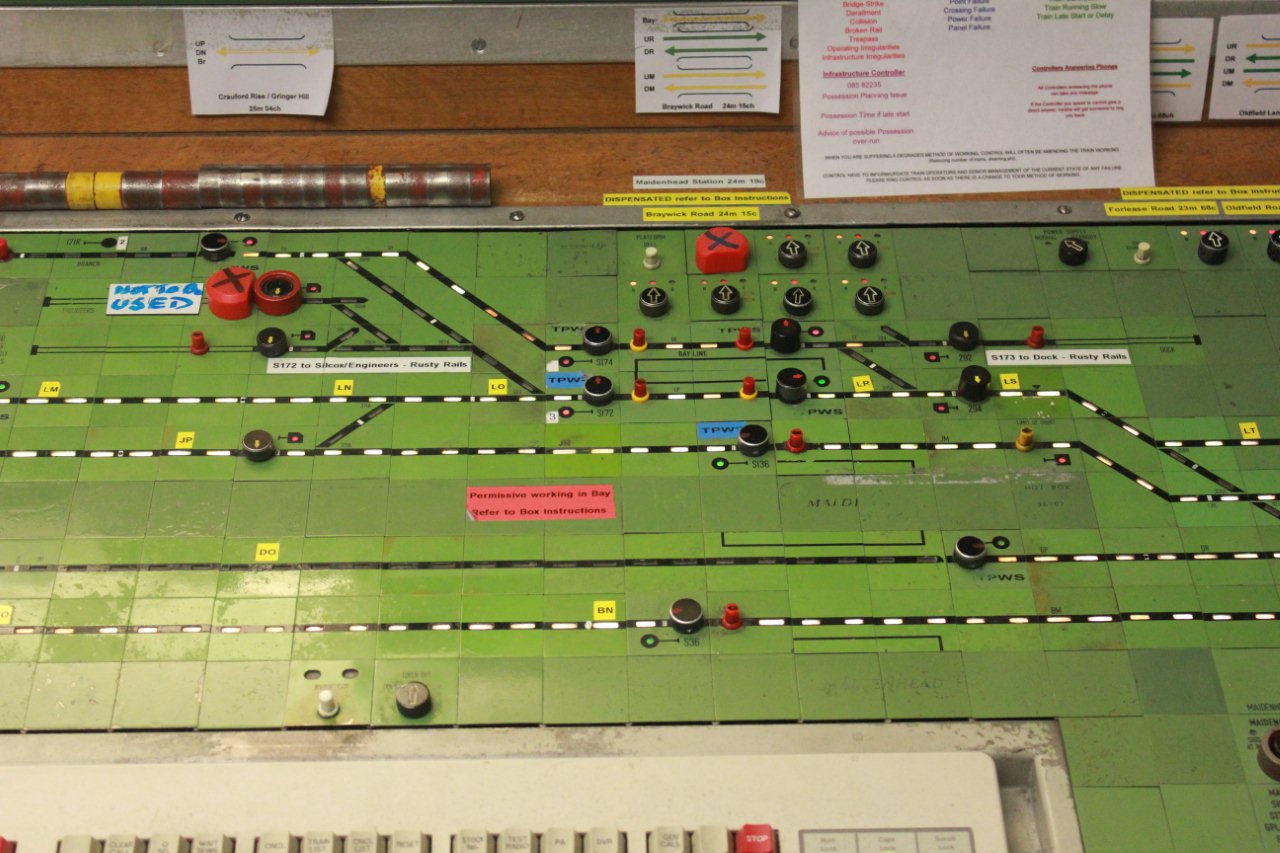 |
Slough PSB, 7 August Slough Panel, showing the Maidenhead area. The buttons just above the keyboard control the token release to Bourne End (White), and from Bourne End (black). Note the protection for the out of use siding. (Mike Walker) |
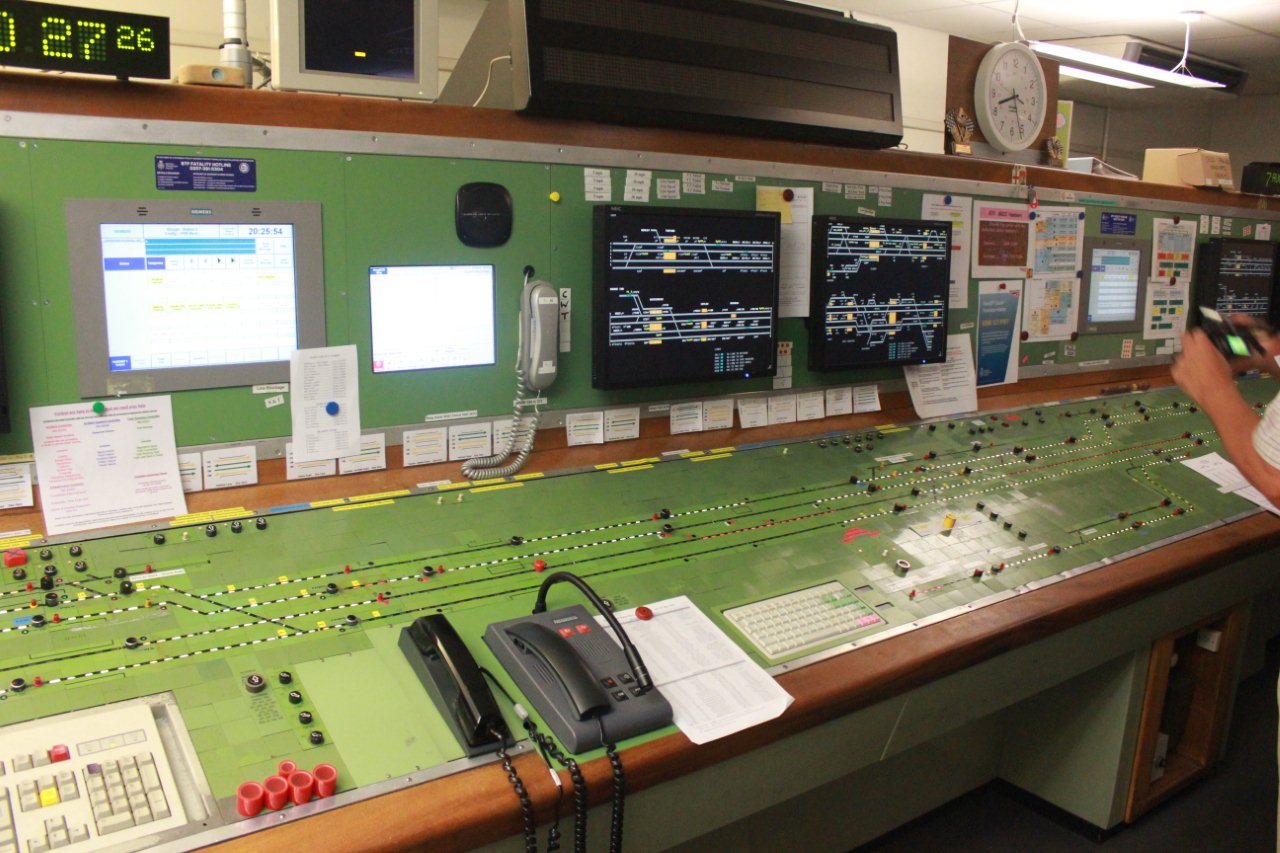 |
Slough PSB, 7 August A general view of Slough Panel, with Maidenhead on the left and Slough on the right. (Mike Walker) |
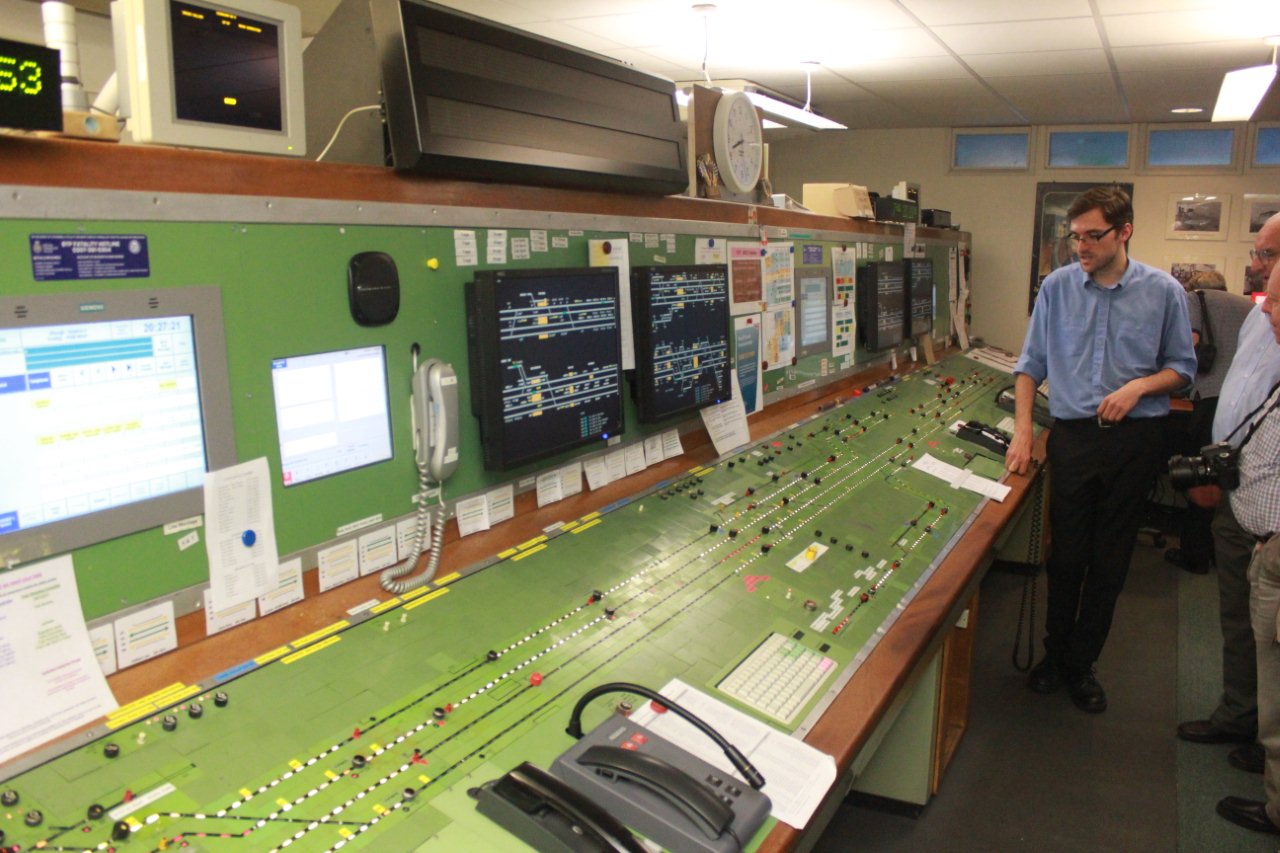 |
Slough PSB, 7 August Danny Scroggins, Network Rail TVSC Operations Manager, explains the operation of the Slough Panel to the MDRS members. (Mike Walker) |
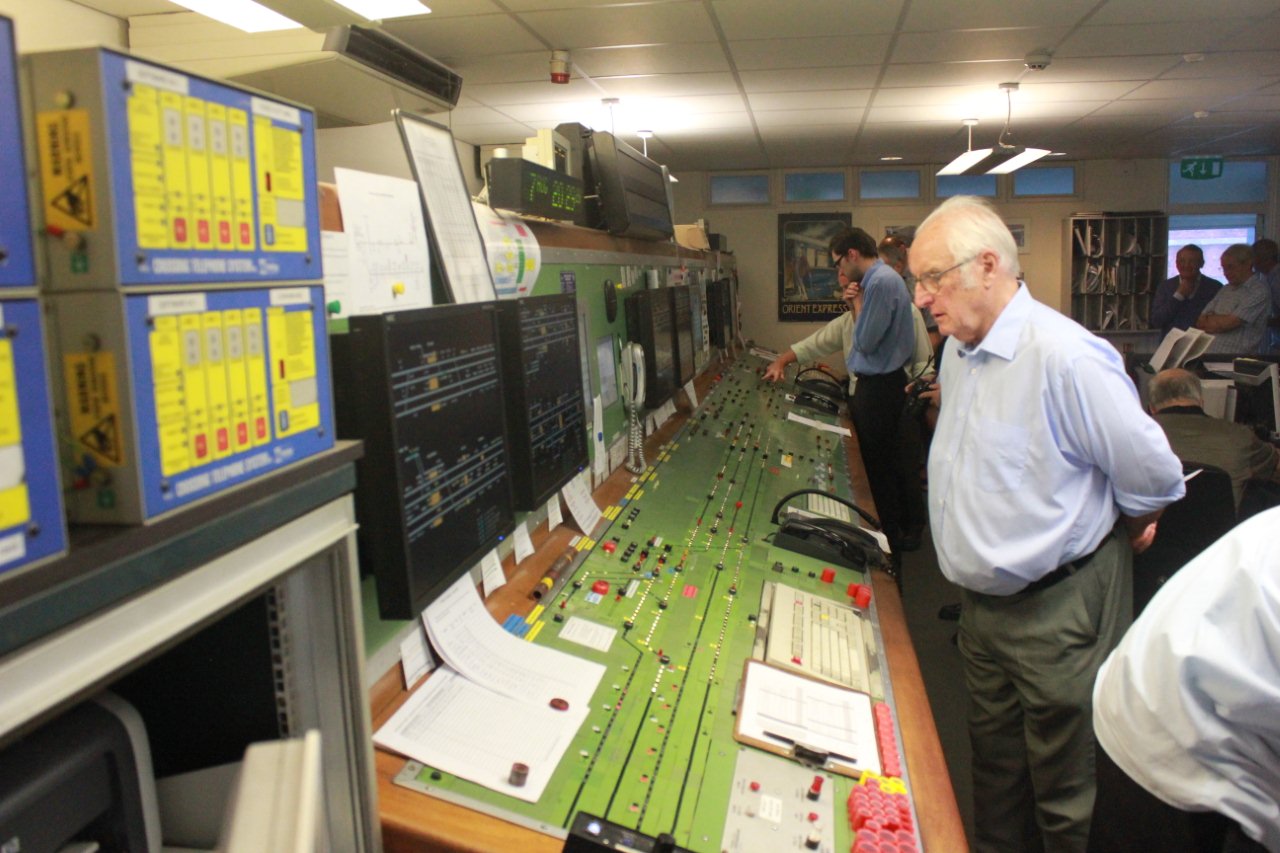 |
Slough PSB, 7 August A MDRS member takes a close look at the Maidenhead section of the Slough Panel. (Mike Walker) |
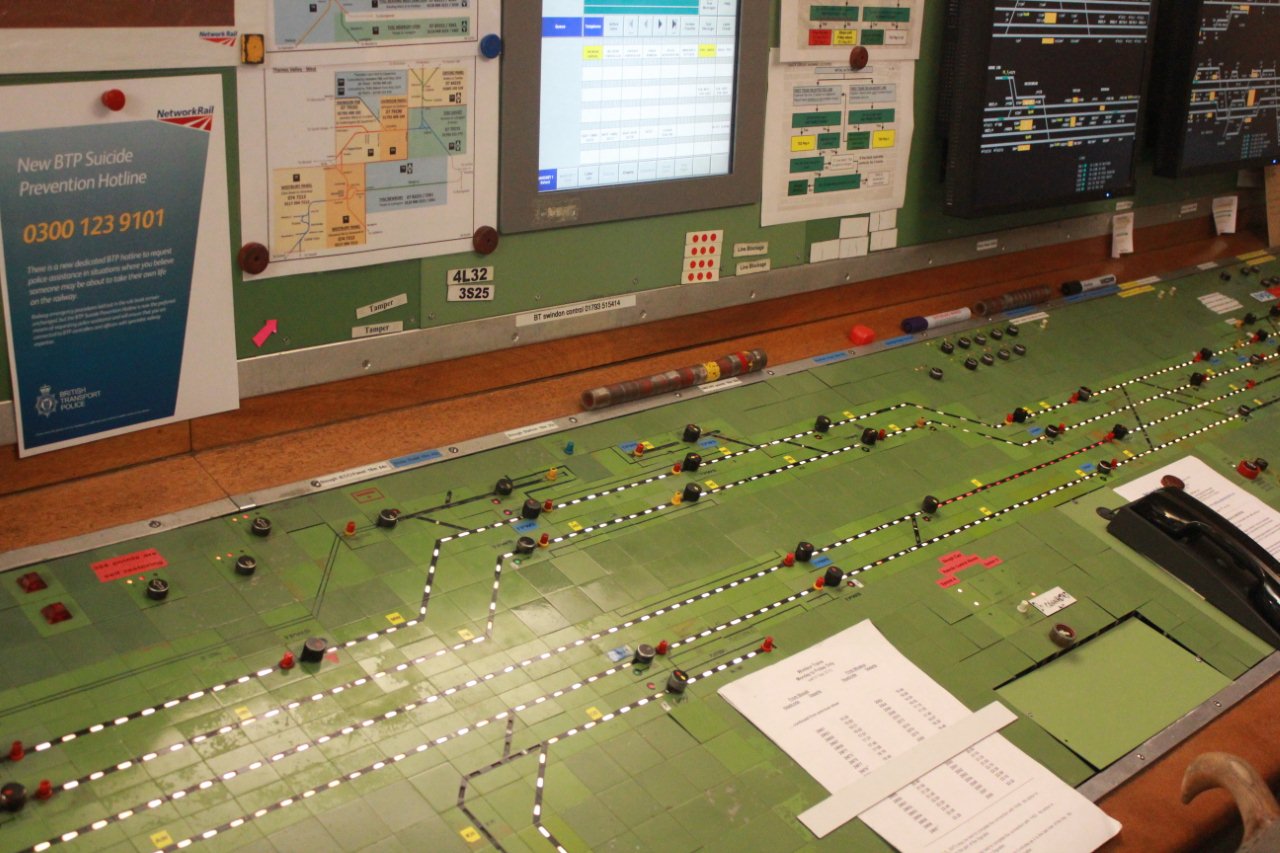 |
Slough PSB, 7 August A close up view of Slough Panel, showing the Slough Station area. The Windsor branch is at the bottom centre. (Mike Walker) |
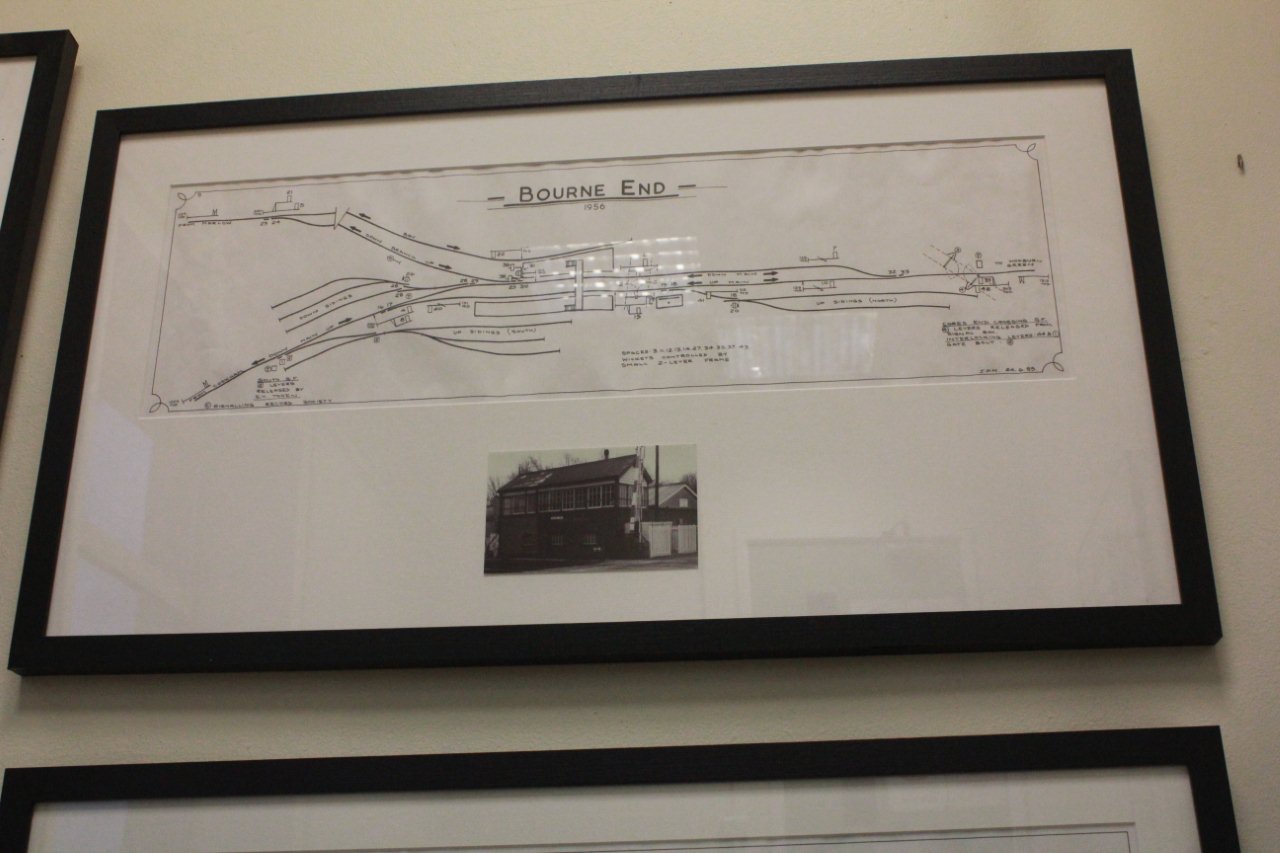 |
Slough PSB, 7 August One of several framed diagrams to be found in the entrance vestibule of Slough Panel Signal Box. This images shows the layout at Bourne End station in 1956, and post dates the closure of the South Box and the extension of the former North Box. (Mike Walker) |
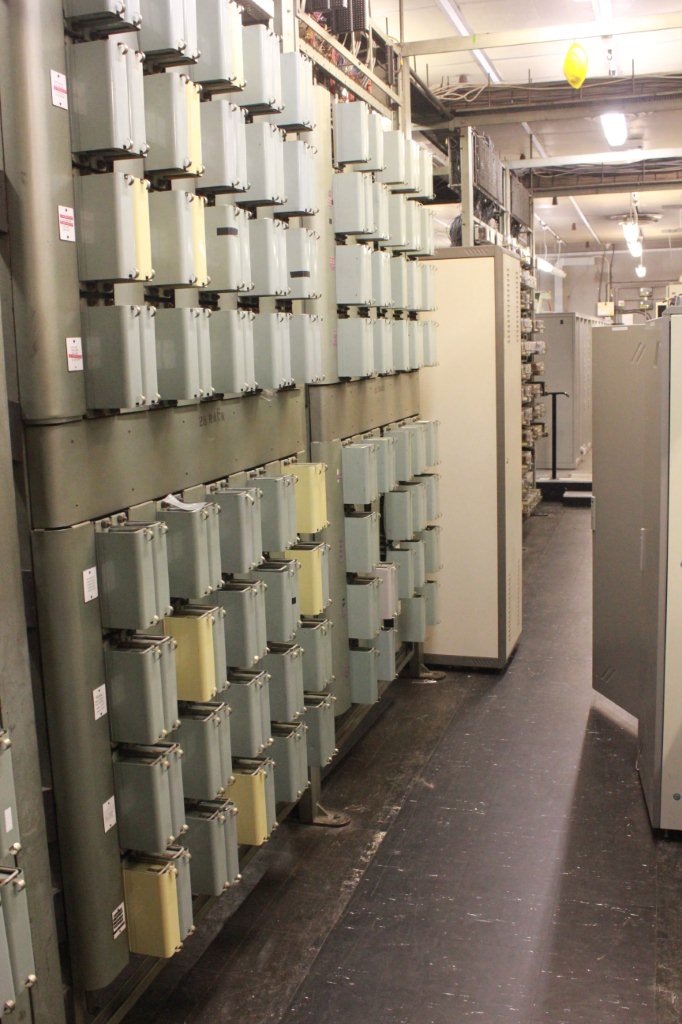 |
Slough PSB, 7 August Part of the electro-mechanical interlocking of Slough Panel. These are the "non-vital" relays, whilst the cabinet beyond contains modern TDM multiplexers. (Mike Walker) |
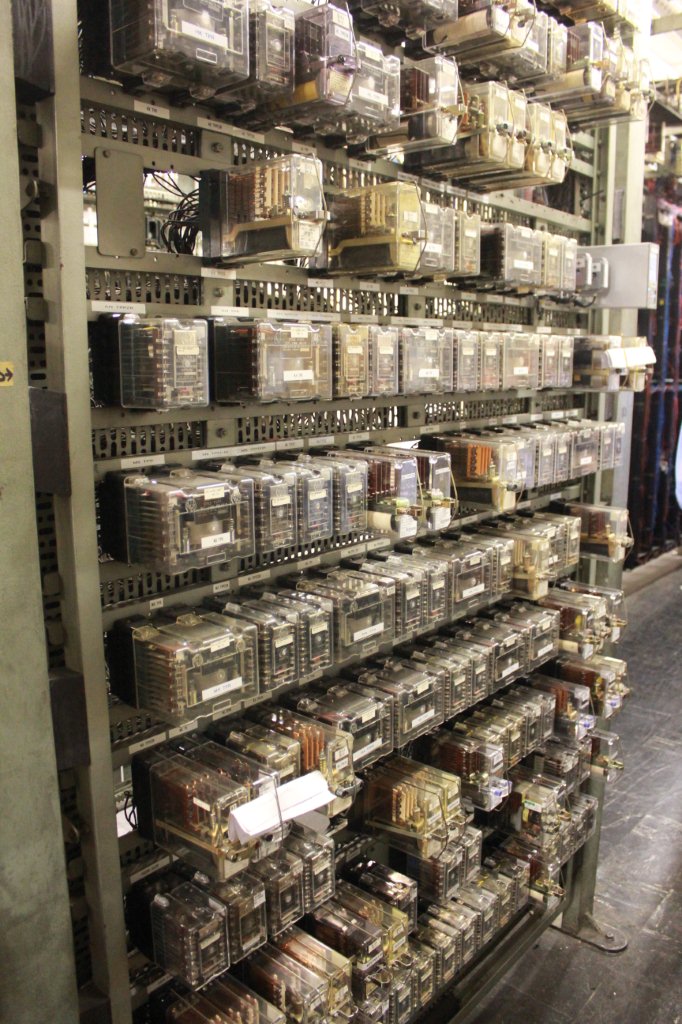 |
Slough PSB, 7 August Another part of the electro-mechanical interlocking of Slough Panel. These are the "vital" miniature relays; which perform the safety critical functions, moving points, clearing signals and detecting that all in functioning correctly. (Mike Walker) |
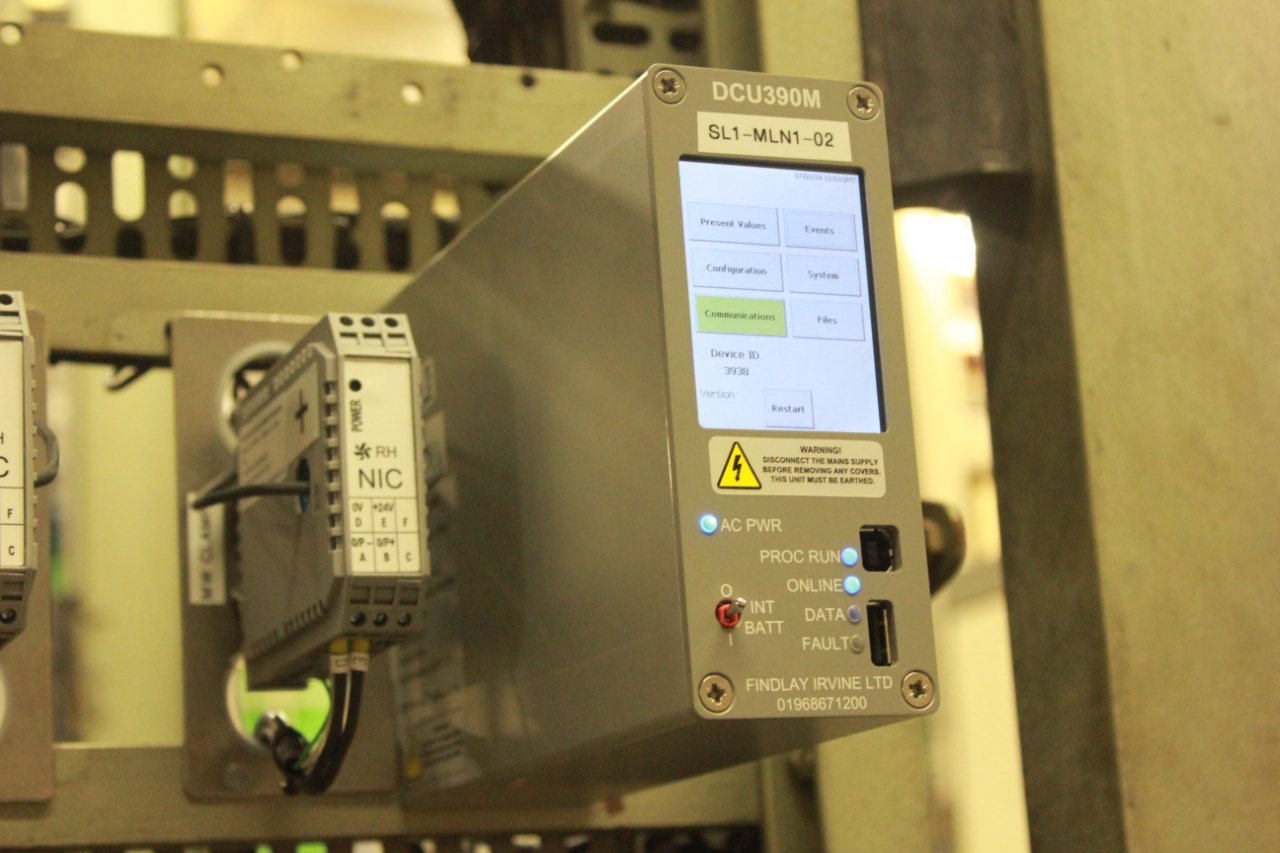 |
Slough PSB, 7 August A remote monitor on the interlocking at Slough Panel. It checks that that current is flowing to the equipment to the left. (Mike Walker) |
Wotton Light Railway
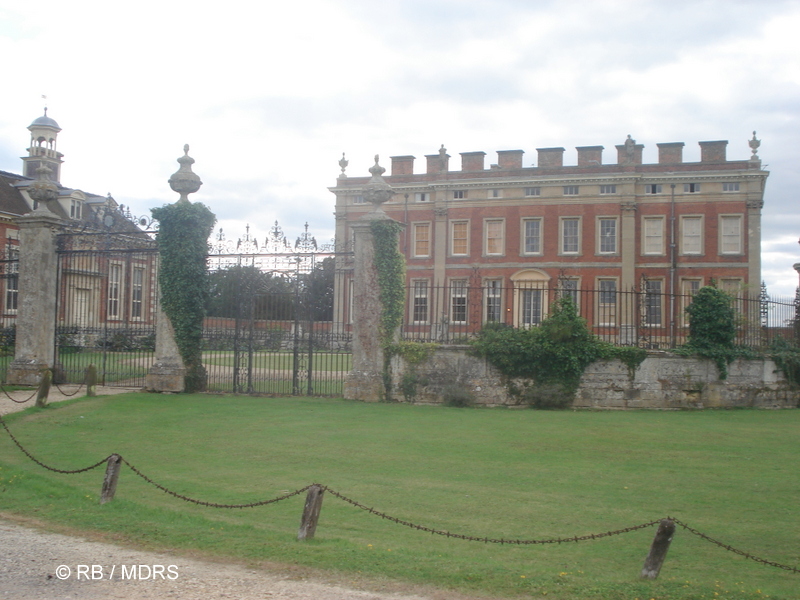 |
Wotton Light Railway, 16 August The WLR is set in land adjoining North Lodge, in part of the extensive estate of Wotton House (pictured). (Roger Bowen) |
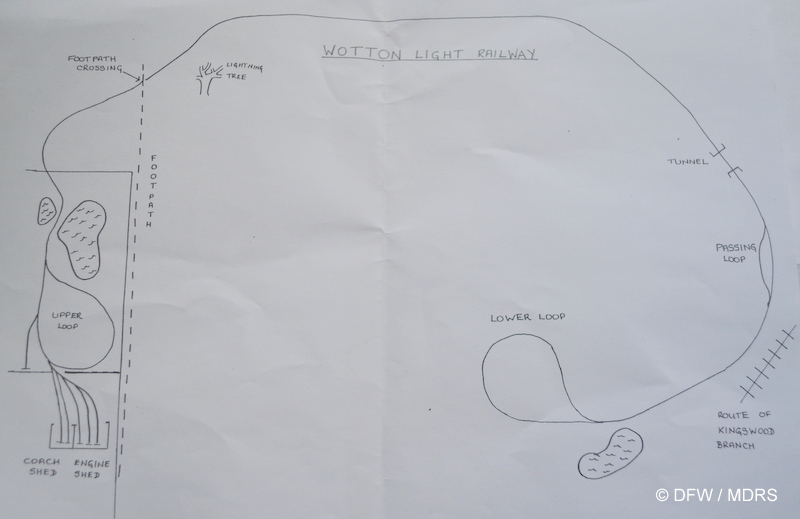 |
Wotton Light Railway, 16 August The WLR is 15" gauge privately owned estate railway, which opened in 1966. It is not open to the public, although groups of railway enthusiasts are often invited to visit. Starting in the upper ballon loop, off which there are sidings to the engine and carriage sheds, and also a works siding. The return journey is just over 1.5 miles, and takes passengers between ponds, through gra sslands and woodlands, across a public foorpath, under a tunnel, via a passing loop to the lower balloon loop. The maximum gradient is 1 in 60, with a minimum radius of 75 feet, at one point near the lower loop the line runs alongside the alignment of the Kingswood branch of the Brill Tramway. The tramway closed in 1935, and the branch in 1915 which was horse drawn to the end. (Dave Woodhead) |
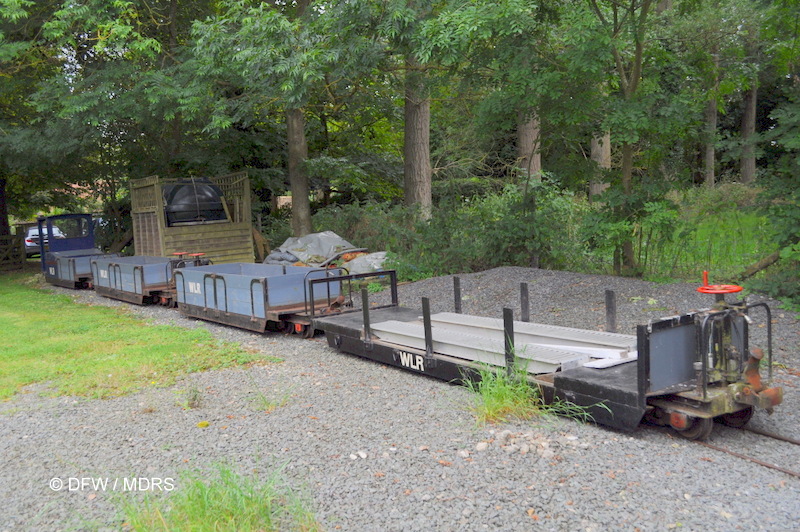 |
Wotton Light Railway, 16 August The goods train consists of one well wagon (nearest the camera), two dropside wagons, and one wagon /tool/brake van (in the distance). These were all built by Alan Keef Ltd. (Dave Woodhead) |
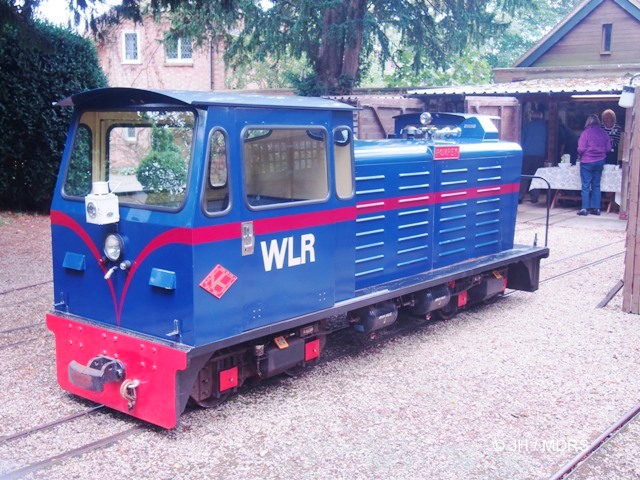 |
Wotton Light Railway, 16 August "Pompey" is a B-B Diesel Mechanical, constructed in 2001 by Alan Keef Ltd and originally carried works No 64. (Julian Heard) |
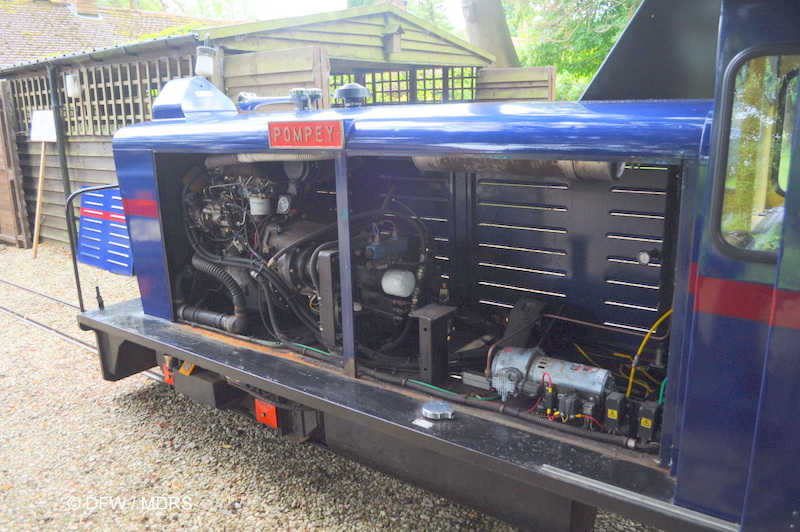 |
Wotton Light Railway, 16 August "Pompey" with the engine side covers removed; showing the 2.7 ltr Perkins 3 cylinder 900 series engine, and International SS400 power shift transmission. The loco has prop-shaft drive to both inboard bogie axles and chain drive to both outer axles. The bogie bolsters are carried on rubber suspension units, and the loco weighs an estimated 4 tonnes. (Dave Woodhead) |
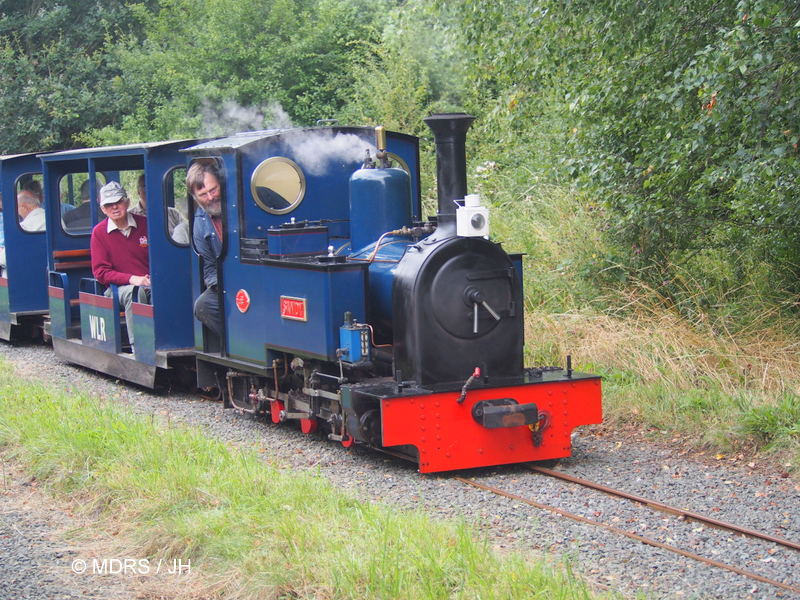 |
Wotton Light Railway, 16 August "Sandy" performing a run past at the passing loop; with several MDRS members on board whilst others having de-trained to obtain the photo. (Julian Heard) |
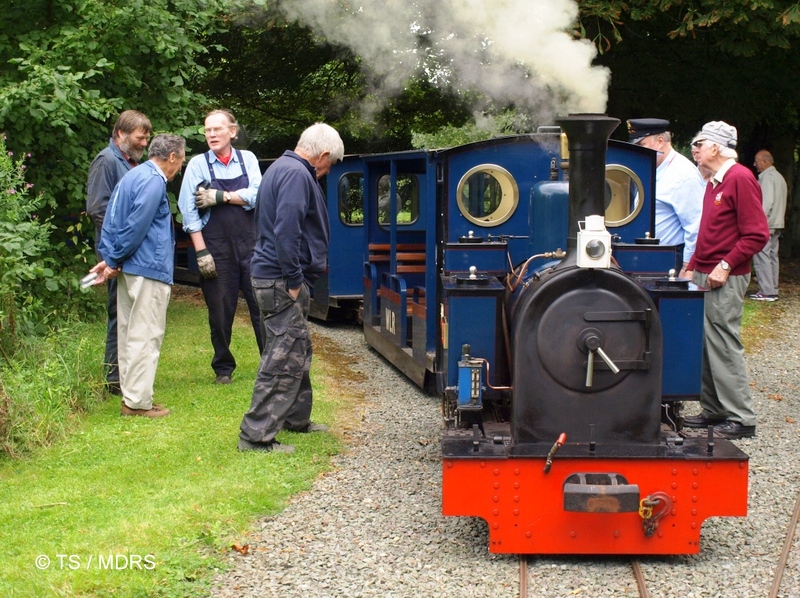 |
Wotton Light Railway, 16 August "Sandy" and train waiting in the upper baloon loop for the next run; the owner and other staff members are standing alonside. (Tim Speechley) |
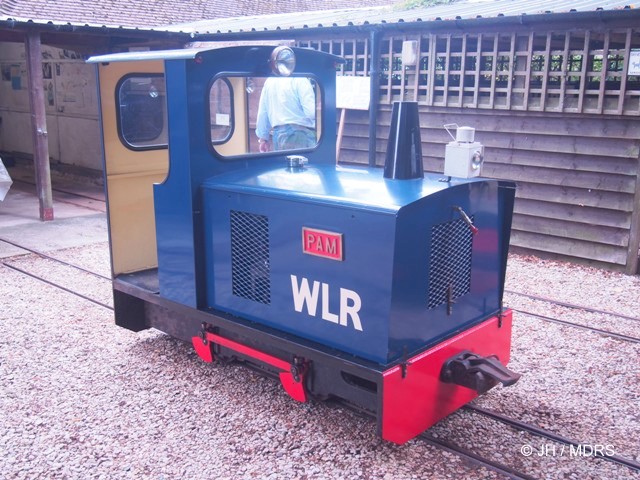 |
Wotton Light Railway, 16 August "Pam" stabled in the engine shed sidings. The loco is an 0-4-0 Diesel Hydraulic, and was also built by Alan Keef Ltd in 1996 with works number 64. It is powered by a 3 cylinder Kubota engine driving a Sauer-Sunderland 90 series hydraulic pump unit which feeds a HTL piston type hydraulic motor with chain drive to the rear axle. Drive to the leading axle is by side rods, and the loco weighs an estimated 1.5 tonnes (Julian Heard) |
New Reading Viaduct and TMD
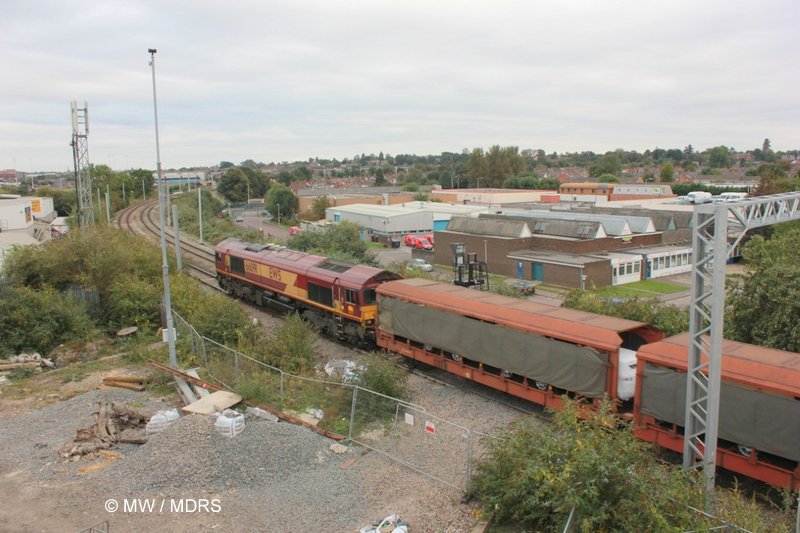 |
New Reading Viaduct, 25 September Seen from the unique viewpoint of the new Reading Viaduct, DB Schenker 66091 emerges from the Reading West Curve with 6O42, the 11.31 Halewood (Jaguar Cars) to Southampton Eastern Docks loaded with Range Rovers for export. (Mike Walker) |
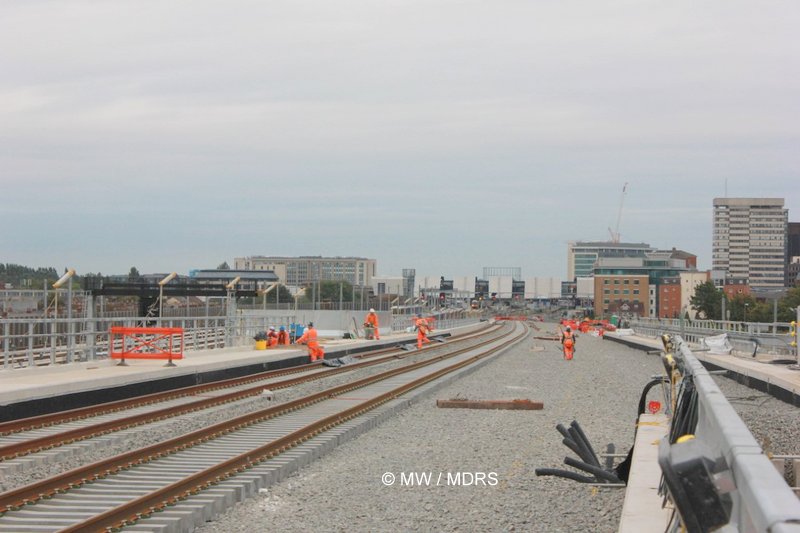 |
New Reading Viaduct, 25 September Another view at what will be Reading High Level Junction where the Festival Line (right) breaks away from the main viaduct structure, clearly showing where the third line will be installed. (Mike Walker) |
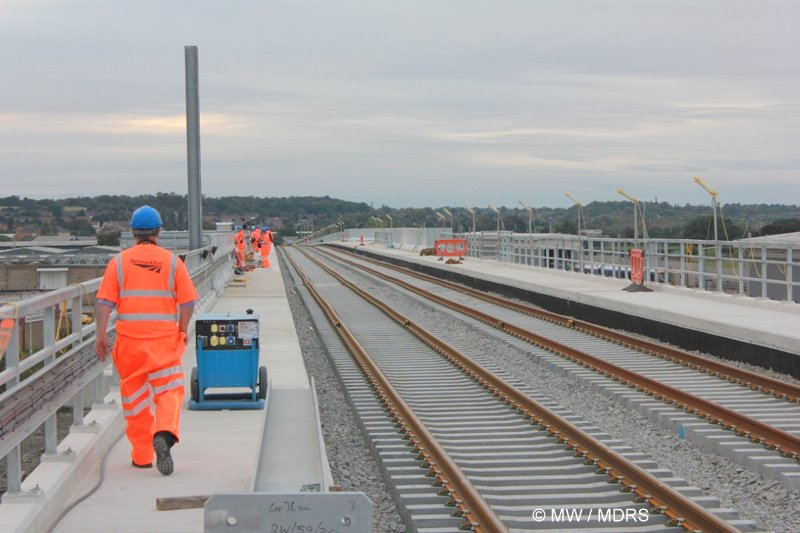 |
New Reading Viaduct, 25 September Reading Viaduct looking west. The centre section of the structure between 36m 49c and 36m 76c rises at 1 in 730 towards the west followed by a 1 in 85 gradient decent down towards Tilehurst as can be seen here. The climb from the station end is an incline of 1 in 93. (Mike Walker) |
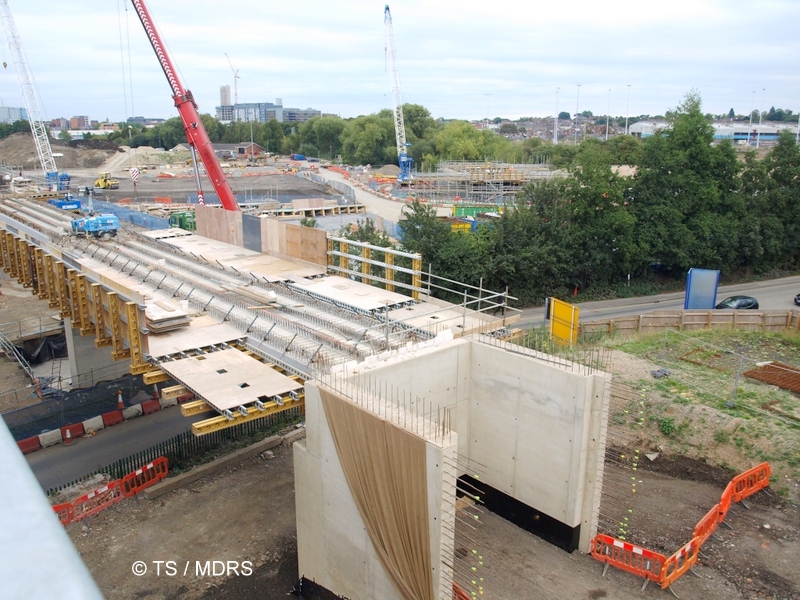 |
New Reading Viaduct, 25 September As part of the Reading Viaduct, there is a much wider road bridge being constructed over Cow Lane. (Tim Speechley) |
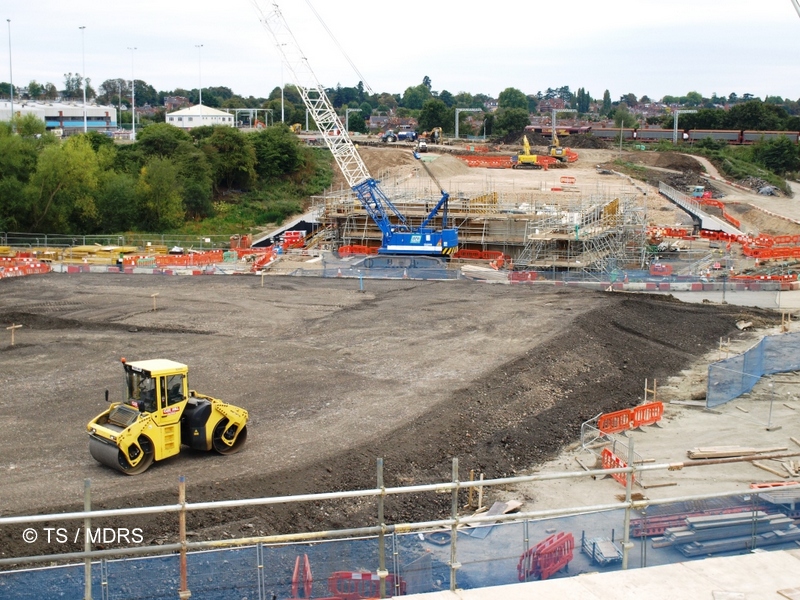 |
New Reading Viaduct, 25 September The extent of the groundworks can be seen looking south from the viaduct towards Basingstoke. The old depot can be seen in the top left. (Tim Speechley) |
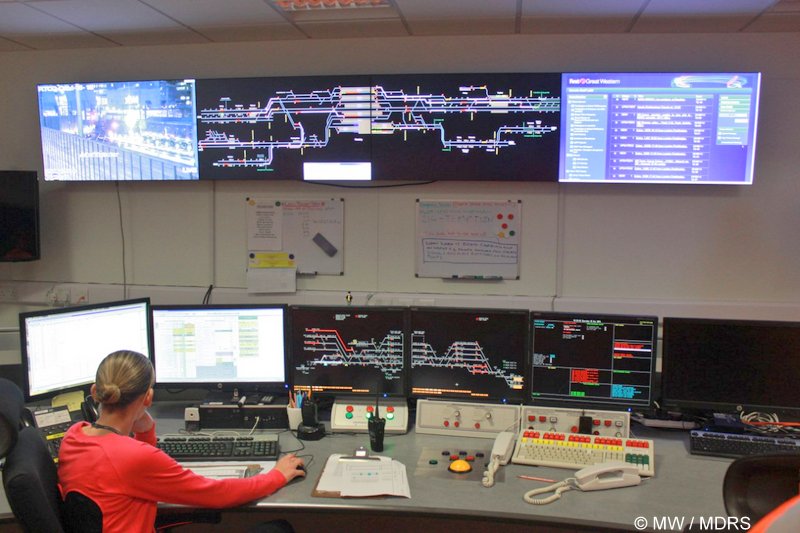 |
New Reading TMD, 25 September The signalling control room of the new Reading TMD. All movements within the depot complex are controlled from here, except for those into and out of the maintenance buildings, which are made under the Depot Protection System and supervised by the staff. (Mike Walker) |
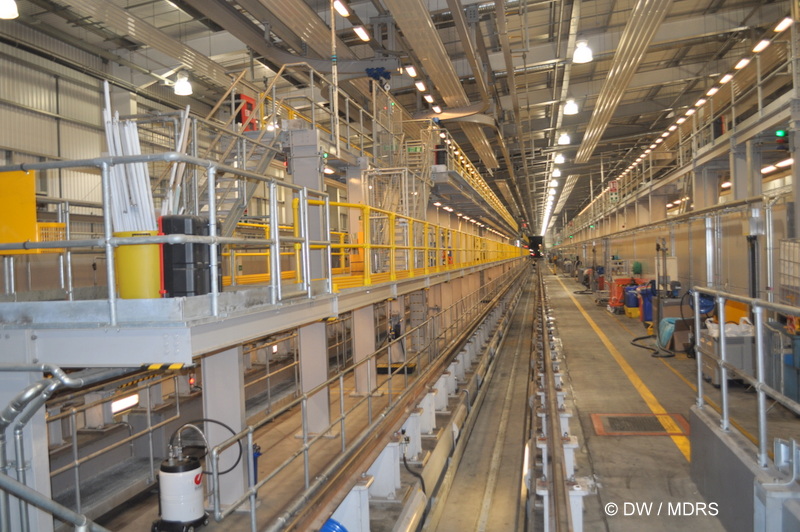 |
New Reading TMD, 25 September The size of the maintenance depot can be appreciated in this picture, with a turbo unit in the distance. Up to three 3 car units can be serviced on each track at the same time. (Dave Woodhead) |
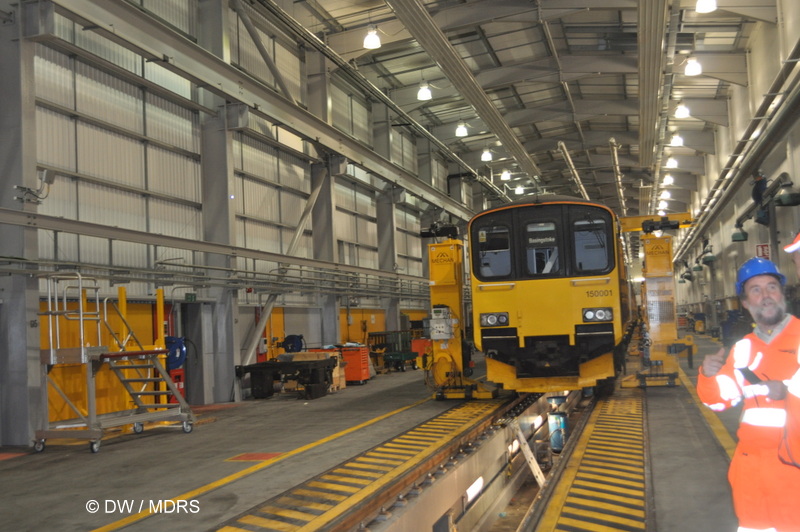 |
New Reading TMD, 25 September Track 4 is a single-ended line used for heavy maintenance, and is equipped with lifting jacks. 150001 (usually on the Reading - Basingstoke shuttle) has just received a transmission change and upgraded head / tail lights. (Dave Woodhead) |
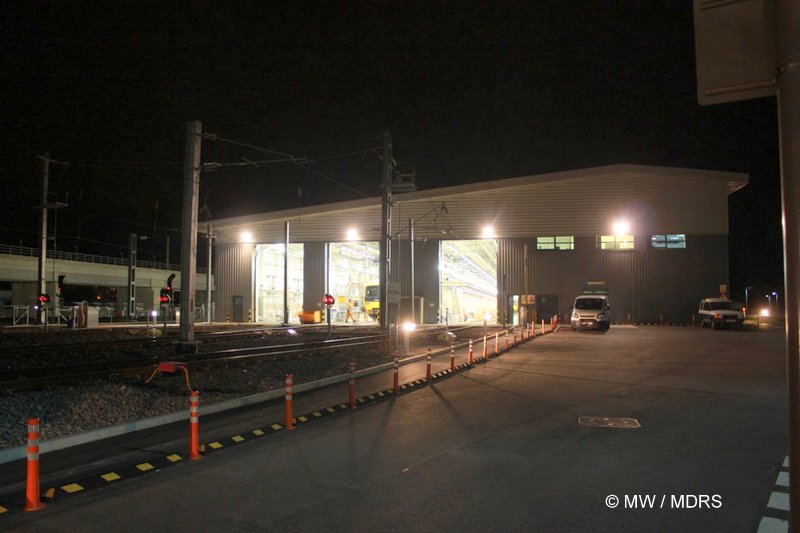 |
New Reading Viaduct, 25 September The east end of the maintenance shed looking in the direction of Tilehurst, 165112 has just entered on track 2 for routine service. The new viaduct is visable on the left of shot. (Mike Walker) |
FGW Celebrations
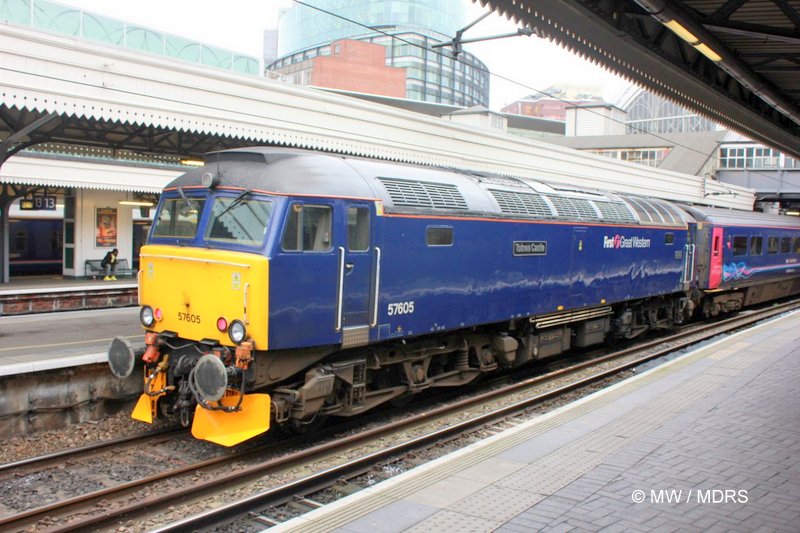 |
First Great Western Celebrations - Greenford Loop, Saturday 18 October First Great Western 57605 "Totnes Castle" stands at Platform 11 at Paddington with the "Night Riviera" stock ready to work 2Z59, the 13:05 special train round the Greenford Loop, as part of the Great Western Heritage Weekend. (Mike Walker) |
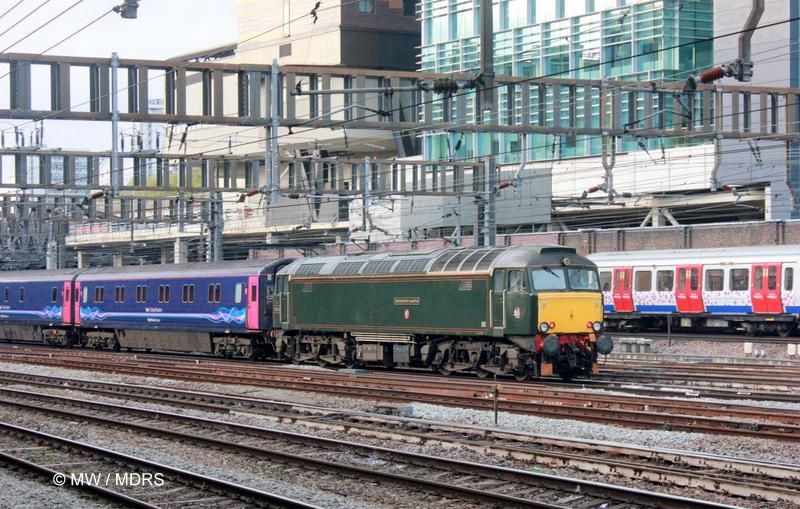 |
First Great Western Celebrations - Greenford Loop, Saturday 18 October First Great Western 57604 "Pendennis Castle" leaves Paddington tailing the "Night Riviera" stock forming 2Z61, the 16:27 special train round the Greenford Loop. This was the last of these workings, as part of the Great Western Heritage Weekend. It is seen passing a London Underground S7 train which is decorated with poppies, to support this year's British Legion Poppy Appeal. (Mike Walker) |
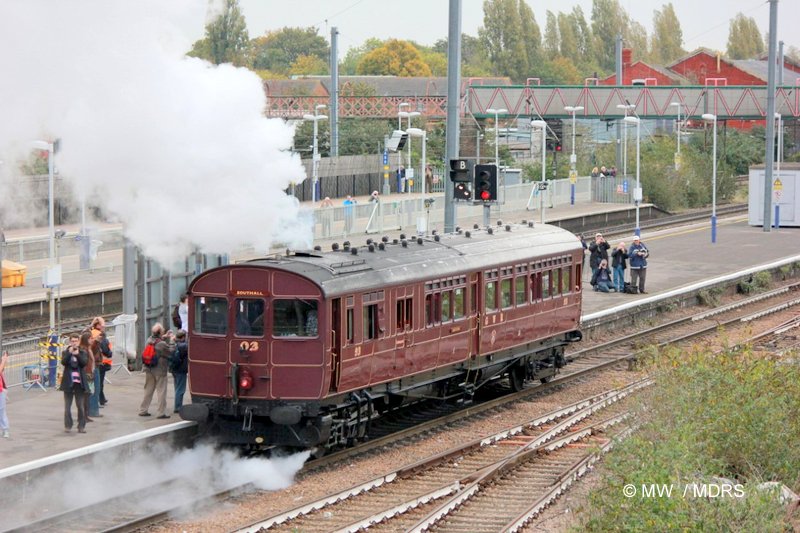 |
First Great Western Celebrations - Brentford Branch, Saturday 18 October After taking on water, which due to using a garden hose with low pressure took over 25 minutes, No 93 makes an impressive departure form Southall on its fourth trip to Brentford on Saturday 18th. (Mike Walker) |
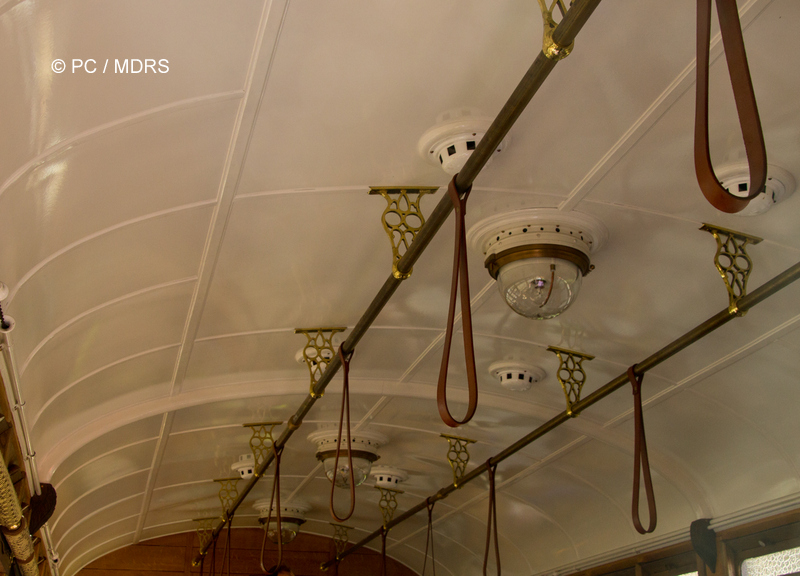 |
First Great Western Celebrations - Brentford Branch, Sunday 19 October The ornate internal decor of railmotor No 93, is clearly illustrated in this view of the lighting, air vents and strap hangers. (Peter Cowley) |
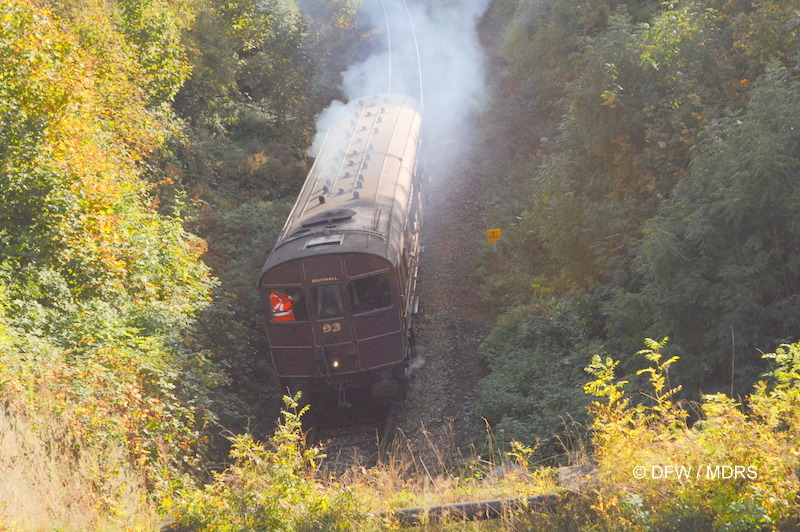 |
First Great Western Celebrations - Brentford Branch, Sunday 19 October Railmotor No 93 approaching Windmill Bridge, where the A4127 Windmill Lane, the Grand Union Canal and Brentford Branch all cross each other at the same location, with the 10.00 return working from Southall. No 93 is succeeding in laying a very effective smokescreen on the climb. (Dave Woodhead) |
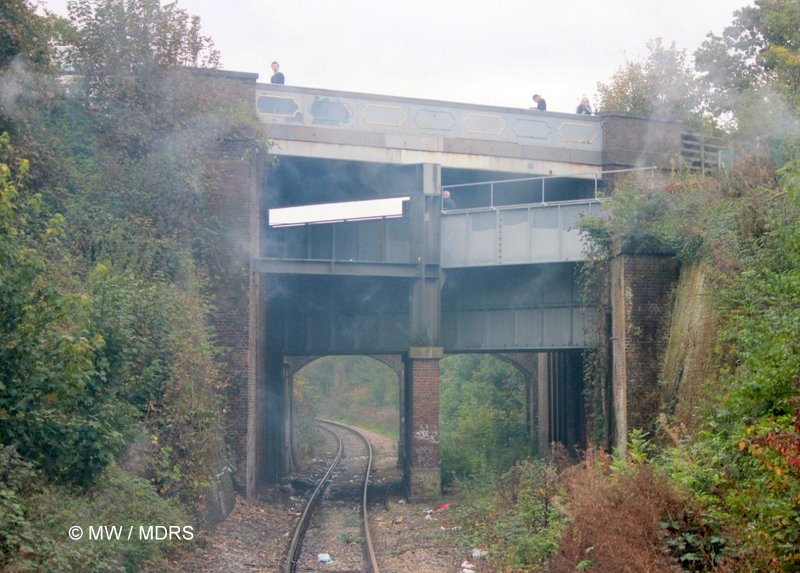 |
First Great Western Celebrations - Brentford Branch, Sunday 19 October A view of the Windmill Bridge layout taken from rail level. This unique shot was made possible, thanks to the crew agreeing to leave the rear cab door open on the return journey from Brentford. (Mike Walker) |
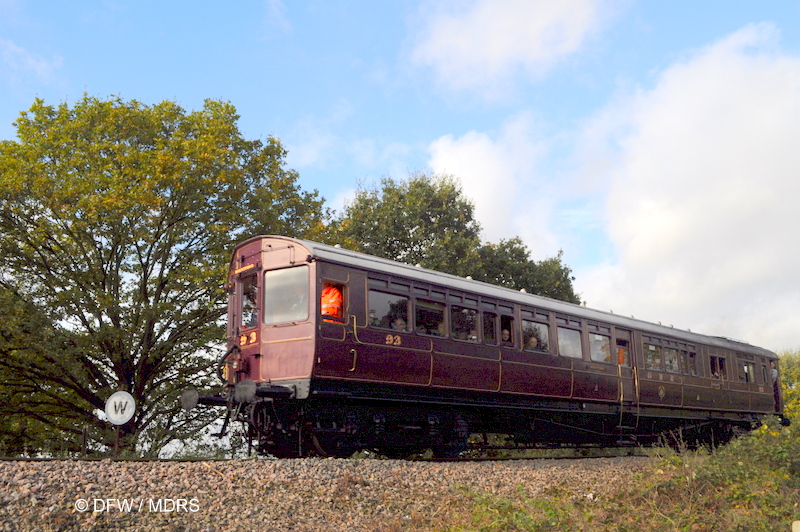 |
First Great Western Celebrations - Brentford Branch, Sunday 19 October GWR Steam Railmotor No 93 is seen approaching Trumpers Crossing on the Brentford Branch, working the 11.00 service from Southall. It has just passed the site of Trumpers Crossing Halt, which had a very short working life of less than 19 years. The station opened on 1 July 1904, temporalily closed from 22 March 1915 to 12 April 1920 due to War Time economy measures, and finally closed on 1 Feb 1926. The station was originally spelt "Halte" because at that time the Great Western used the French spelling, but later the e was removed. After closure, materials from the redundant platforms, were used to construct South Greenford station whiich opened 5 months later. (Dave Woodhead) |
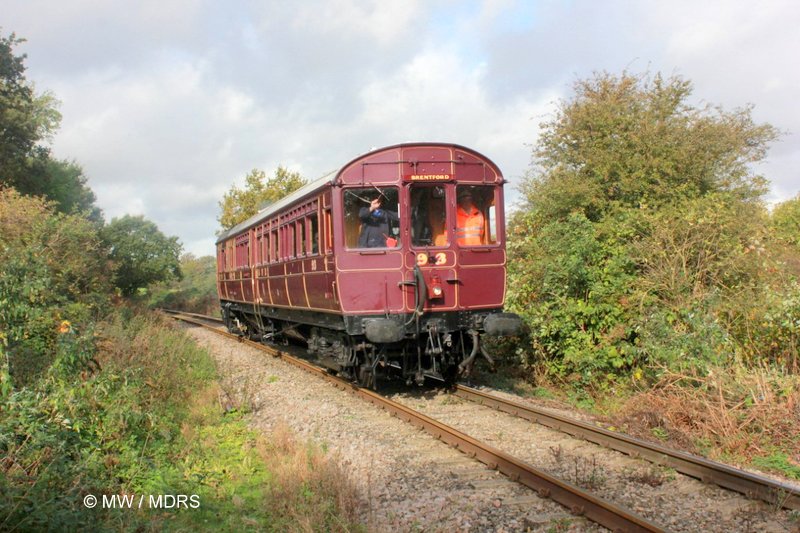 |
First Great Western Celebrations - Brentford Branch, Sunday 19 October Steam Railmotor No 93 is seen approaching Warren Farm Crossing working the 11.00 service from Southall. (Mike Walker) |
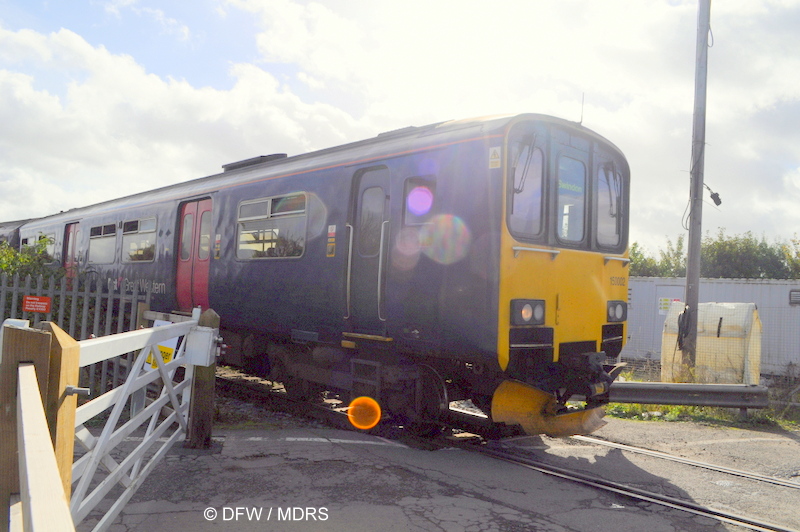 |
First Great Western Celebrations - Colnbrook Branch, Sunday 19 October First Great Western unit 150002 is seen passing the manually operated crossing just off Tavistock Road, 400 mtr from the country end of West Drayton Station, with 2Z28, the 12:00 special to Colnbrook as part of the Great Western Heritage Weekend. (Dave Woodhead) |
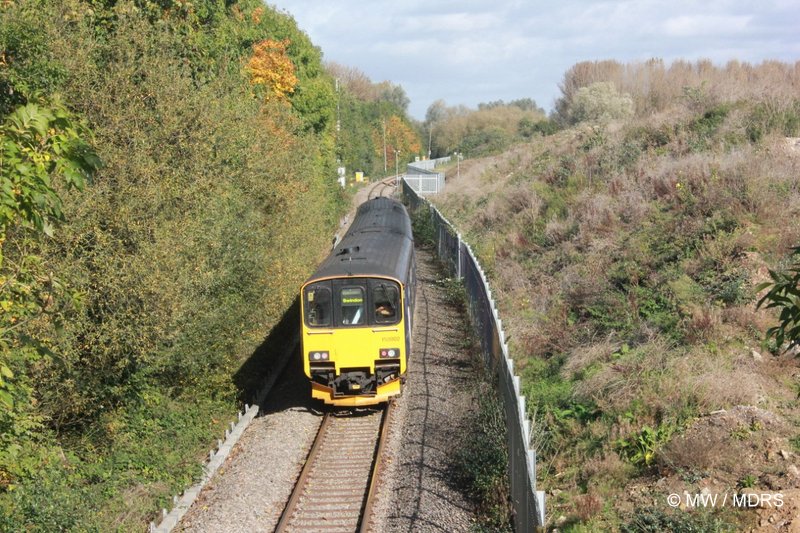 |
First Great Western Celebrations - Colnbrook Branch, Sunday 19 October In unaccustomed surroundings, First Great Western 150002 passes the Thorney Mill Road bridge with 2Z28, the returning 12:00 special over the Colnbrook Branch as part of the Great Western Heritage Weekend.The exit from the Lafarge sidings can be seen just beyond the unit.The special workings went as far as the Stop board just beyond the M4 / M25 interchange, and just short of the Colnbrook Logistics sidings. (Mike Walker) |
| HOME | ABOUT US | PROGRAMME | THE DONKEY | GALLERY | LOCAL RAILWAYS | LINKS |